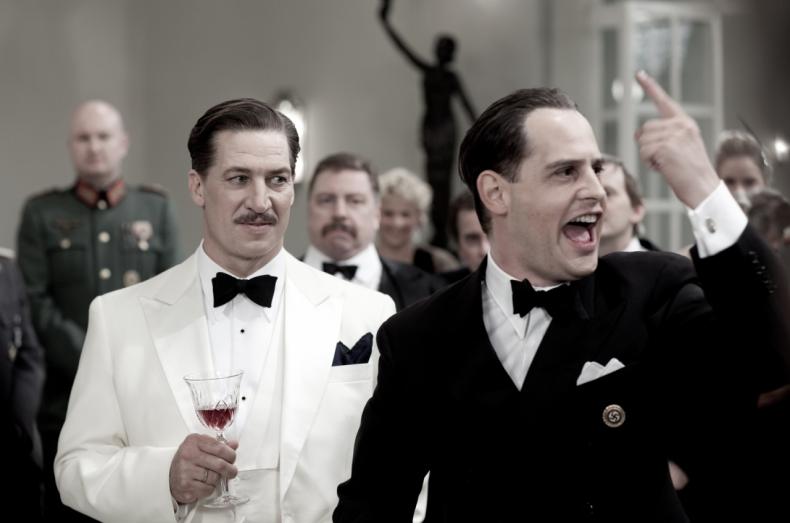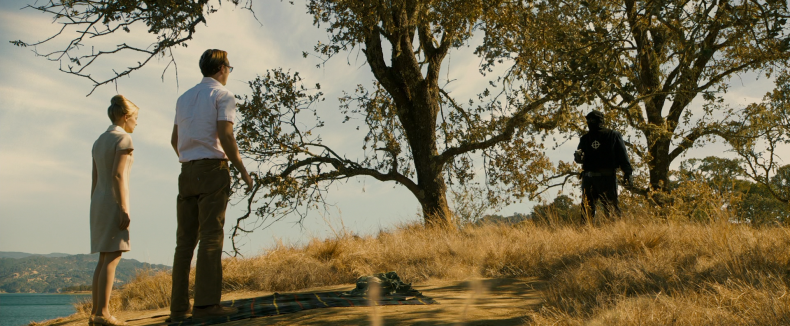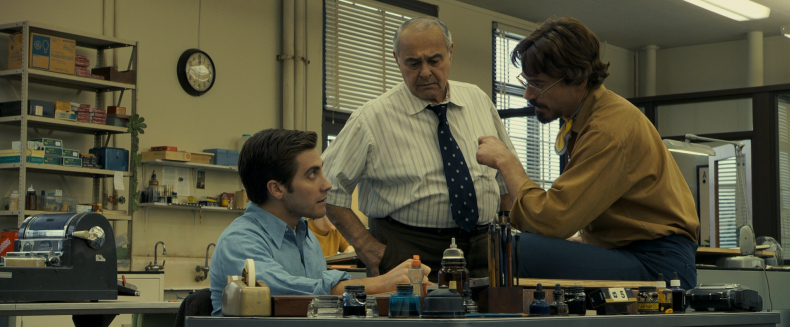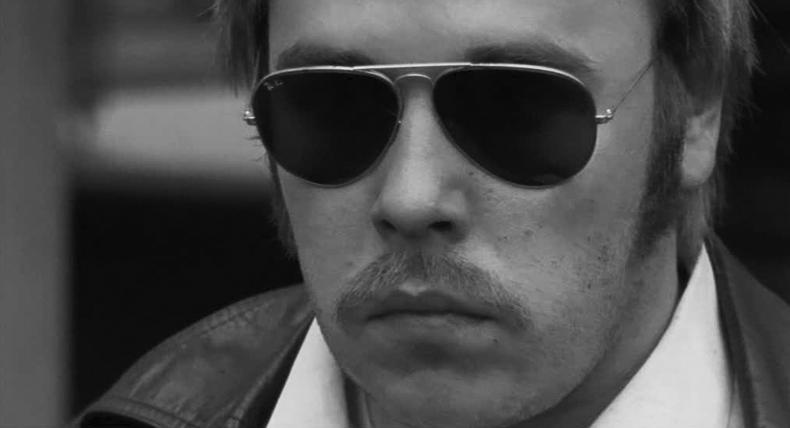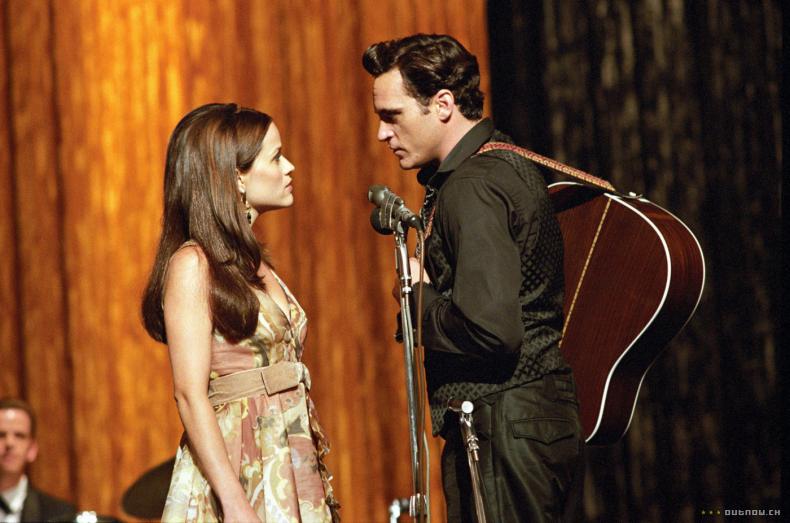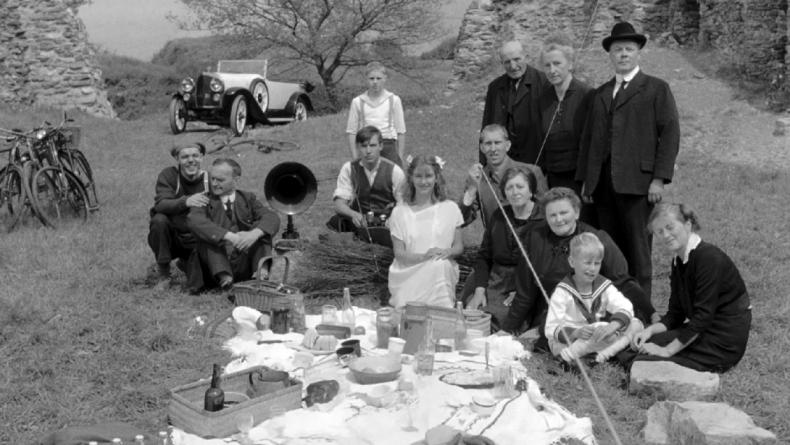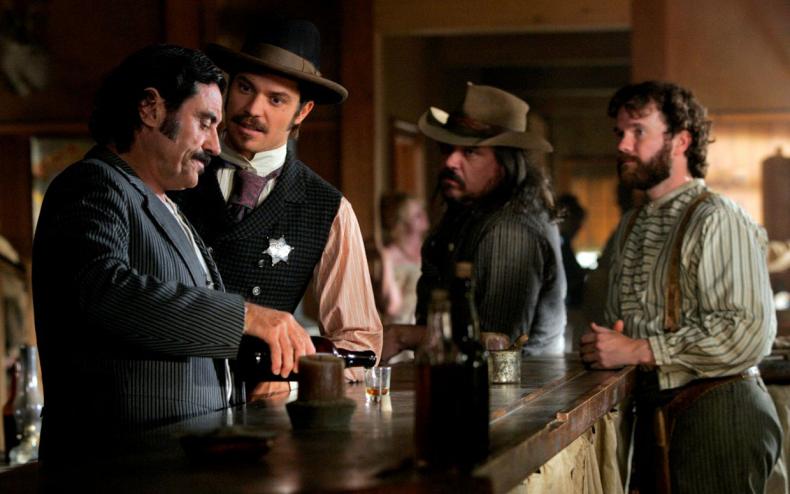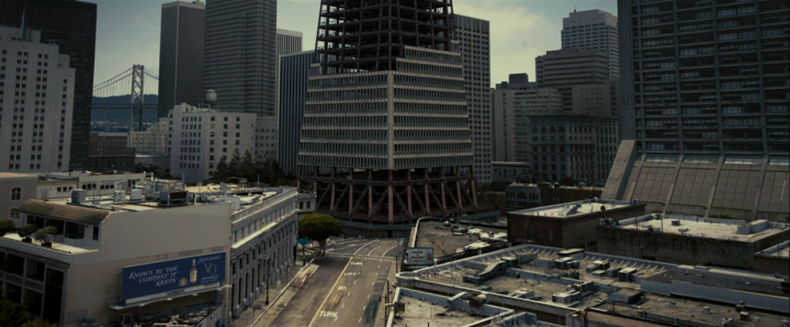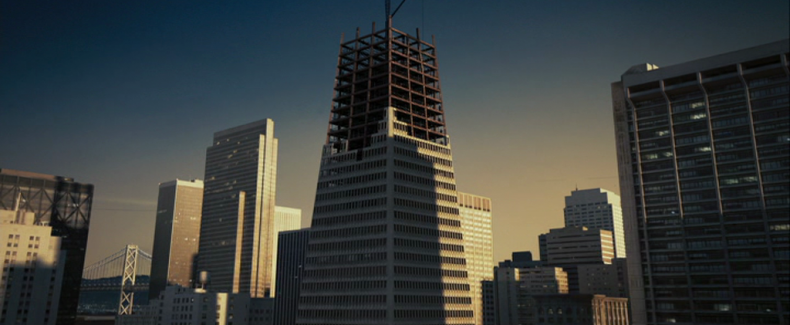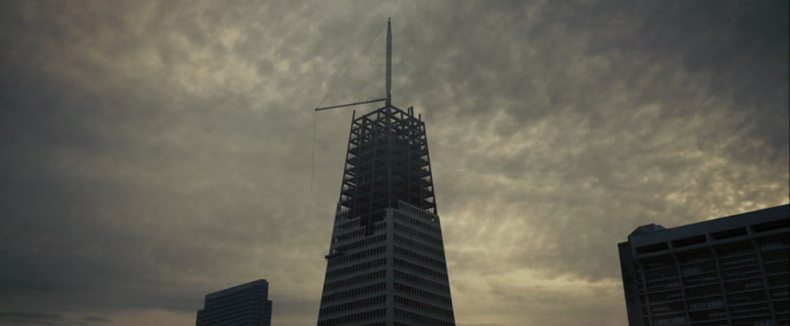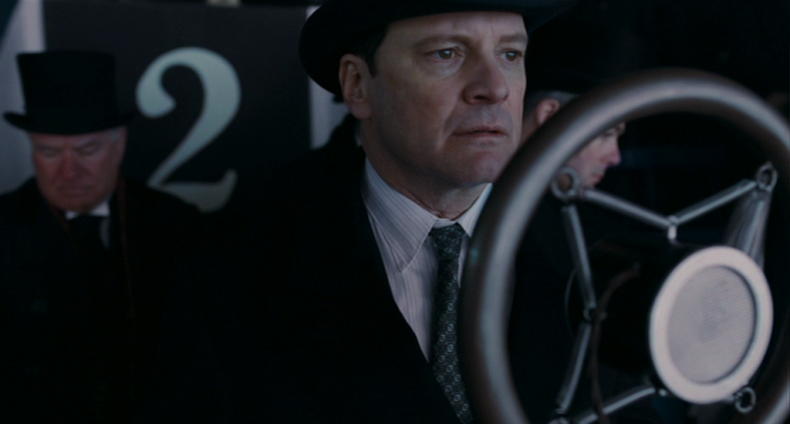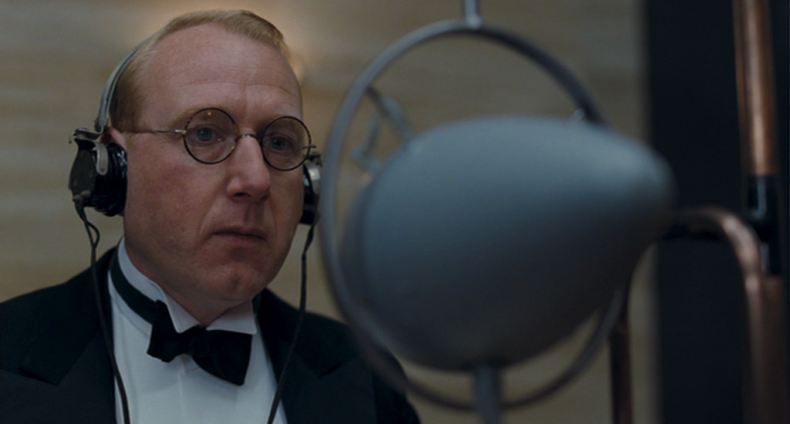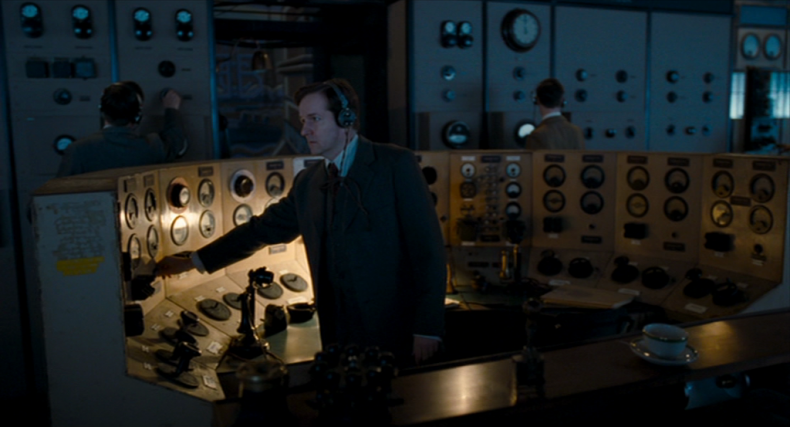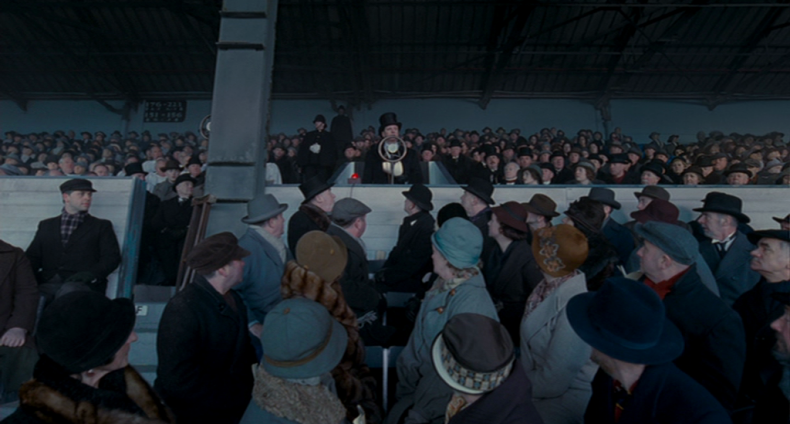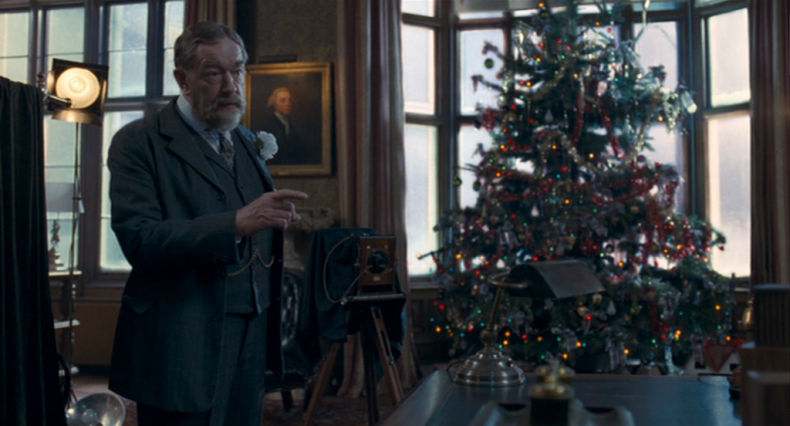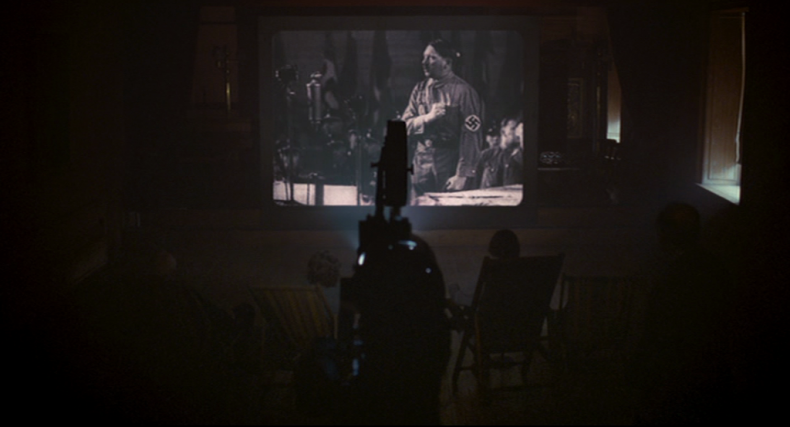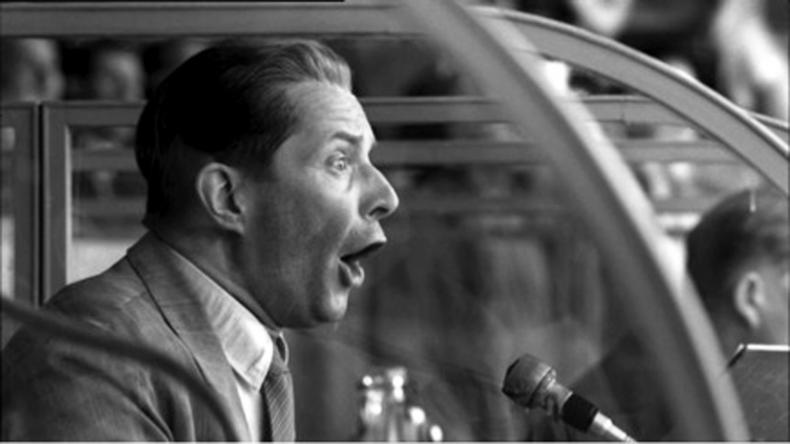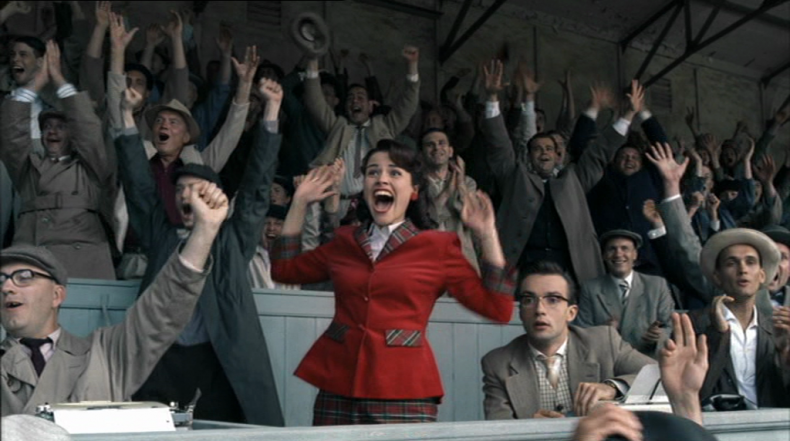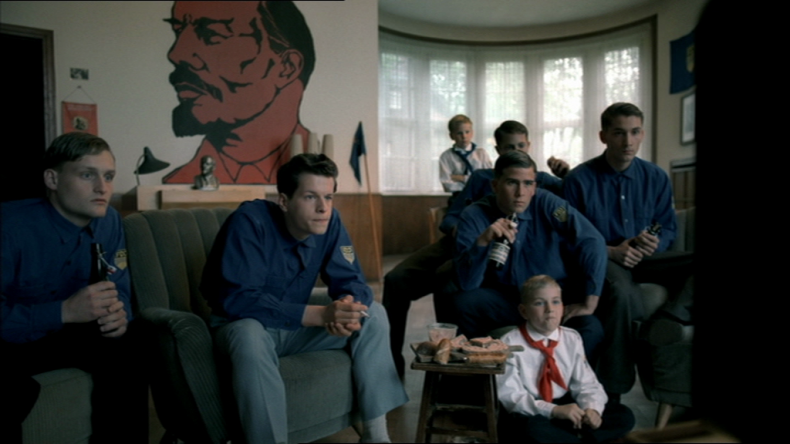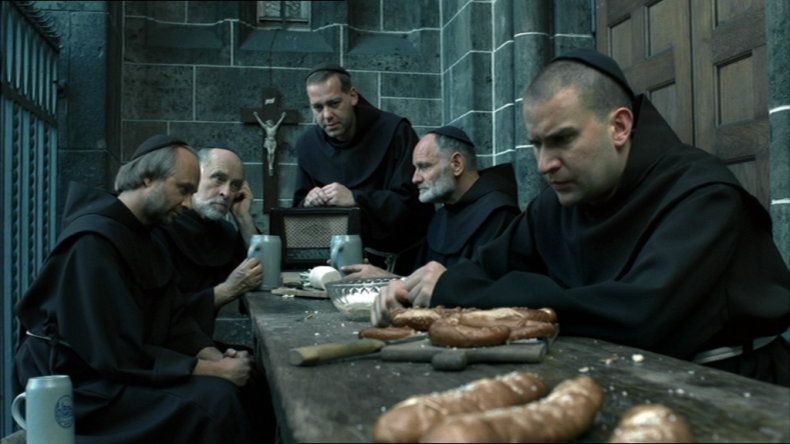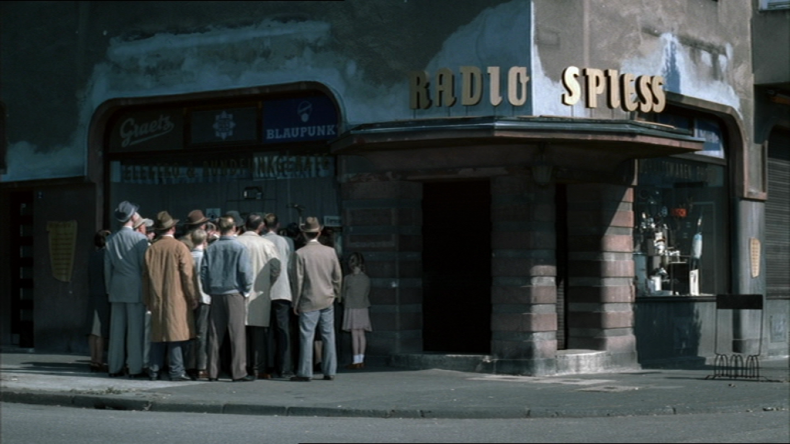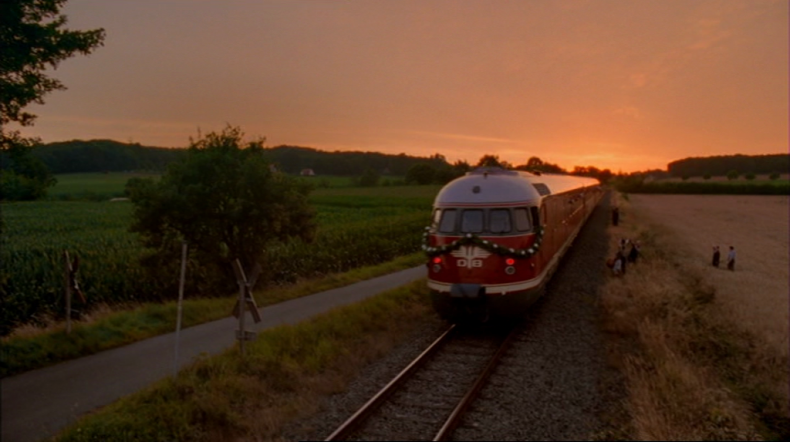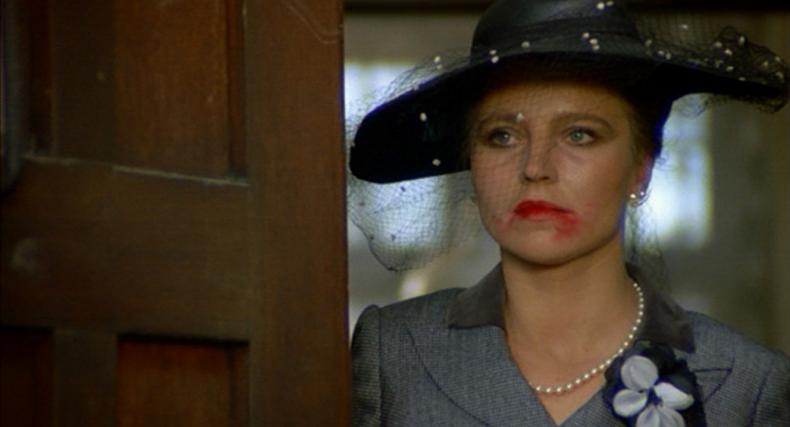The Authenticity Feeling
Language and Dialect in the Historical Film
This is an Open Access article distributed under the terms of the CC BY-NC-ND 4.0 License.
Suggested Citation: Frey, Mattias: The Authenticity Feeling: Language and Dialect in the Historical Film. In: Research in Film and History. New Approaches (2018), pp. 1–48. DOI: https://doi.org/10.25969/mediarep/14811.
1The pursuit of authenticity is film’s dominant mode of historical representation. For the overwhelming majority of historical film makers and audiences, authenticity signifies a realistic historical experience, an effective suspension of temporal-spatial disbelief. Authenticity, as the engine of mainstream historical filmmaking, has three chief functions: as an aesthetic strategy, a reception discourse and a marketing discourse. A feeling, a form of perception and (supposed) knowledge, the aesthetic success of authenticity, and thus the mainstream historical film, is assessed via the following question: Has the past been conveyed in a way that the spectator can reconcile with his or her perception of the historical reality? Audiences speak of films that “bring history to life”.2 I call this condition – this sensation of a media-produced, purportedly successful historicity – the ‚authenticity feeling‘.
To be sure, authenticity and the authenticity feeling are products of particular domains and styles of representation, including costume and music. Precisely because authenticity remains, among many audiences and critics, the most important benchmark in the evaluation of historical filmmaking, however, it must be understood and examined as a chief characteristic of marketing and reception discourses. Interviews with actors, directors and other film personnel, advertising campaigns and Making Of featurettes frequently and consistently refer to the quantity and quality of pre-production historical research. The producers of ZODIAC (David Fincher, USA 2007), we learn for example, used helicopters and cement to plant trees on a barren California island in order to precisely reconstruct a murder scene due for a mere smattering of shooting days. On the ‚San Francisco Chronicle‘-set, production designers sourced painstakingly elaborate replicas of every page of each day’s newspaper, even though they never appear on camera. Such meticulous forms of realism, the prop master Hope M. Parrish explains in the Making Of, help the actors slip into their roles. The screenwriter and other personnel justify this obsessive degree of historical reconstruction with auteurist appeals: according to them, David Fincher is no mere perfectionist, but above all the consummate, uncompromising artist, and the pursuit of visual authenticity represents a sort of method acting for sets, props and locations. (Fincher himself never speaks; the production designer, costume designer and make-up artist admire him from the distance as talking heads.) Furthermore, and above all in recreating instances of human suffering – ZODIAC revolves around a serial killing spree in northern California in the late 1960s – filmmakers appeal to a sense of moral duty to stay as close as possible to known and knowable facts, as a gesture of respect to the victims. This is certainly not a phenomenon restricted to the CGI-era. Film historians such as George Custen register exemplary 1930s Cecil B. DeMille productions by which authenticity essentially shapes both aesthetics and marketing.3
Authenticity has been and remains the most prominent element in historical films’ reception discourse. Scholars never tire to explain the extent to which historians, critics and lay audiences evaluate historical films according to the meter of “accuracy and authenticity.” 4 Above all, critical reviews and academic articles seek to clarify the extent to which the film corresponds to the “real events” and “official records”. Ridiculed and rejected by film scholars as the “fidelity discourse”, this approach considers the film as the reflection of an already existent and indisputably superior description of reality. As Jonathan Stubbs opines, “achievement in the historical film genre is often judged according to the perception of historical accuracy rather than by aesthetic criteria.”5
The impression of authenticity, and the warm, righteous feeling it catalyses, fundamentally shape the reception of historical films, particularly among lay audiences. There is no shortage of sources which report that in BRAVEHEART (Mel Gibson, USA 1995), set in thirteenth-century Scotland, a white van and a man with a baseball cap can be seen, or that in GLADIATOR (Ridley Scott, USA 2000) a gas bottle appears in the back of a Roman chariot.6 IMDb maintains categories for goofs and anachronisms so that users can, for example, flag up and discuss the extras in SPARTACUS (Stanley Kubrick, USA 1960) who wear a wrist watch.7 The American humour magazine Cracked asked its readers to upload the “most glaring mistakes” in film onto a webpage that eventually attracted over 1.5 million hits. Most users – and the winners of the competition – highlighted errors in period films. Among them: Jack, protagonist of TITANIC (James Cameron, USA 1997) supposedly comes from a town in Wisconsin that in reality was founded five years after his death. RAIDERS OF THE LOST ARK (Steven Spielberg, USA 1981) depicts a German military operation in Egypt that is not only invented, but also, because of the British occupation during the period, would have been impossible. In a BACK TO THE FUTURE (Robert Zemeckis, USA 1985) scene meant to be set in 1953, Marty (Michael J. Fox) plays a Gibson ES335 guitar, a model that was not sold until three years later.8 A fan culture that collects and disseminates such continuity errors exists among blogs, forums, Wikipedia entries, YouTube videos and books, which serve this culture and its interests.9As we shall see, empirical studies demonstrate that, for a significant proportion of audiences, the search for “mistakes” and the engagement with the details of the historical mise-en-scène represent the “pleasure”, “source of active enjoyment” and “most important motivation” for the consumption of historical films.10
Authenticity is, for it many proponents, ultimately a felt, sensual, even embodied historicity: the authenticity feeling. Its detractors belittle authenticity as historicism, an arduous yet naïve representational form and artistic habitus that attempts to approach the past in an uncritical and affirmative manner. In this article I seek to disrupt the critical consensus and propose two main arguments. First, authenticity, as an aesthetic strategy, and the authenticity feeling, as a measure and characteristic of reception, are important social phenomena that must be considered more closely and dissected more systematically. Second, sound – and above all language and dialect – plays an essential and hitherto little studied part in the production of the authenticity feeling. In order to write an Audio History of Film, it is essential to better understand the authenticity feeling; only via a rigorous analysis of the historical film’s acoustic elements can one comprehend authenticity as a marketing discourse and means of reception.
Authenticity Criticism
Today, there are many critics who write lengthy, often embittered condemnations of filmmakers’ authenticity efforts. According to the opinion of Katja Nicodemus (Die Zeit), there should be a “multiyear prohibition . . . for the one street used as a historical location at the Babelsberg studio”.11 Alluding to Walter Benjamin, Nicodemus ridicules contemporary German historical films and their “deeply museal engagement with their visual representation” as whores in the bordello of historicism: “it seems as if the German cinema, with its prop-schlepping, its over-enthusiastic recreators . . . has fooled around with precisely this historical whore”. Nicodemus is hardly alone in her critique of the “parasitic shamelessness of the German nostalgia film”. According to taz-critic Cristina Nord, it suffices these days “when the license plate in the film matches the one in real life”. Indeed, if “there is anything resembling a program” among these films, “it expresses itself in the fetishisation of authenticity”. The aesthetic focus on historical details, according to Nord, is part and parcel of a “new naïveté”.12
Such opinions are not only widely held among German film critics. The former NYU professor Robert Sklar criticised THE BAADER MEINHOF COMPLEX (DER BAADER MEINHOF KOMPLEX, Uli Edel, D 2008) in a similar way: “Its idea of interpreting the past is to try to match on screen the same number of bullets that were expended in the actual event”.13 Directors such as Romuald Karmakar, Christian Petzold and Andres Veiel complain about “stylisation of the past”, a “historical over-consolidation that is simply disgusting”. They reject the attempts of productions such as THE MIRACLE OF BERN (DAS WUNDER VON BERN, Sönke Wortmann, D/A 2003) GOOD BYE, LENIN! (Wolfgang Becker, D 2003) and DOWNFALL (DER UNTERGANG, Oliver Hirschbiegel, D 2004) for wanting to “end history with a full stop”.14 In (conscious or unconscious) reference to Linda Williams’ definition of pornography (a genre that above all aims for “maximum visibility”), some “Berlin School” filmmakers speak of “history porn” when describing such films.15Authenticity criticism is an international phenomenon with a long pre-history: film scholars such as Stubbs refer to the tradition of leftist critique of historical films, which are supposedly too preoccupied with costumes and detailed mise-en-scène.16
The most well-known instance of authenticity criticism took place in the context of the 1990s “heritage film” debate. Andrew Higson delivered the most prominent contributions in his various publications on the British costume dramas of the 1980s and 1990s.17 Higson describes the “discourse of authenticity” thus: “the desire to establish the adaptation of a heritage property (whether conceived as historical period, novel, play, building, personage, décor, or fashion) as an authentic reproduction of the original”.18 Revealingly, this formulation foregrounds the relationship between original and copy: historical films and their production processes function essentially as adaptations. Measured in this way, historical films suffer from the traditional status of reproduction (in the history of art and otherwise): second-rate fakes that prey on the original in order to appropriate the latter’s reputation. Authenticity criticism places historical films under the general suspicion of being no more than leeches:
One central representational strategy of the heritage film is the reproduction of literary texts, artefacts, and landscapes which already have a privileged status within the accepted definition of the national heritage.19
According to Higson, heritage films cling to the cultural capital of written historiography as well as that of documents, artefacts or monuments.
The authenticity critics involved in this debate judged heritage films in often caustic terms. For Richard Dyer and Ginette Vincendeau – who extended the British discussion to contemporary Continental period productions – heritage films are “characterised above all by a museum aesthetic”, maintaining an “apparently meticulous period accuracy, but clean, beautifully lit, and clearly on display”.20 Indeed, in the course of the debate, the films were often accused of an “aesthetic of display”. According to these commentators, the productions seek to configure unreflective ‚Heimat‘ fantasies with a fixation on the mise-en-scène, e.g., with lighting, cinematography and editing that emphasise the detailed reconstruction of costumes. Moreover, they claim, this stylisation serves to represent, and thus glorify, the upper classes. Implicitly and explicitly, the scholars and critics attempt to yoke the “conservative” aesthetic together with conservative politics and, furthermore, a conservative audience.
It is important to emphasise that the heritage-film authenticity critics analyse their objects of inquiry in a ‚normative‘ way. Professor, newspaper columnist or blogger alike: all commentators thematise the productions as a means to criticise them. In the opinion of Claire Monk, the heritage film is therefore not a genre in the conventional sense, but rather a kind of warning label:
the construction of the idea of the ‘heritage film’ is interesting for its entanglements of political criticisms with a gut-level cultural aesthetic aversion to the films on the part of its many critics.21
To my mind this vehement antipathy towards the historical film – a culturally contingent, sociologically decipherable curiosity of the history of taste – inhibits a productive engagement with an Audio History of Film. Elsewhere, I refer to the weaknesses of such authenticity criticism. For instance, critics dismiss the productions out of hand, without undertaking differentiated analyses of individual examples or accounting for unique historical receptions; they suspect (erroneously) that the films appeal mainly to women, gays and/or conservatives, a problematic assumption that reveals suspicions of “visual pleasure”.22
In the context of this study of Audio History, however, new insights are necessary. First of all, it is important to note the authenticity critics’ fixation on visual elements. For example, Nicodemus discusses problems with the “visual representation”, the “picture”, “Grandpa’s ‚Wehrmachtsuniform‘ and discarded disco balls”, the “Technicolor aesthetic”, or the “typical brown-beige patina of the German coming-to-terms-with-the-past film”, i.e., props, costumes, production design and their ‚visual‘ representation. The one single exception – Nicodemus mentions her dismissive attitude towards “violin excesses” – proves the rule.23 The critics of the “new naïveté” and “history porn” seem to have few problems with any “maximum audibility”, in other words, the engagement with sound. Is there less to criticise about the concerted search for and detailed rendering of sound, than there is regarding the production design? Or is this aspect neglected by the makers of historical films and can thus, according to the logic of these commentators, be ignored in such critiques? As the lengthy discussion of dialect, music and so on in this chapter demonstrates, at least the second question can be answered in the negative.
Second, both the authenticity discourse, in general, and authenticity criticism, in particular, are important symptoms for the considerable cultural importance of filmic historiography: feelings run high. The laborious aesthetic, the extensive reports on the effort and money expended in this process in marketing discourses, as well as critics’ furious objections demonstrate clearly how much remains at stake. Historical films are not seldom national issues. The press detailed how the US President Barack Obama “teared up” while watching THE BUTLER (USA 2013).24 German Federal Chancellor Gerhard Schröder, cabinet ministers, the Hungarian ambassador and the Swiss general consul attended the premiere of THE MIRACLE OF BERN in Essen. The chancellor, who had a public persona as a macho, had already seen the rough cut of the film in his official residence in Berlin and admitted having had cried three times.25 Historical films are among the most frequently screened audiovisual media in classrooms. The Federal Agency for Civic Education has published teaching materials so that German history teachers and foreign teachers of the German language can use generic exemplars to convey postwar German history.26
These are dramatic fiction films, but also so much more. The debates surrounding historical authenticity are aesthetic questions about representation, but ultimately ontological questions about the essence of the historical film and its identitarian functions. Commentators contest ‚how‘ history should be best and most credibly represented, but they also seek to resolve a deeper dilemma: If history is represented in this particular way, ‚who‘are we? The focus on authenticity in marketing discourses is surely a strategy to foreclose a negative reception via reports of extensive and time-consuming research. The authenticity discourse attempts to veil and prevent aesthetic judgments: “It’s just a film” and “That’s how it really was”, when spoken by filmmakers or historical witnesses become indisputable (if contradictory) responses to any criticism. The deafening noise that is the authenticity discourse drowns out more subtle, subjunctive and counterfactual questions about form, effect, affect and audience engagement. How ‚could‘ history have been best conveyed, in this case? Did the spectator understand the larger implications of the representations? ‚What‘ did he or she understand?
Nevertheless, authenticity critics – reviewers as well as many historians and film scholars27 – ignore the significant resonance of authenticity in popular discourse: the historical film remains one of the most popular and successful film genres.28 An Adornian argument – i.e., that audiences only engage with or expect “authentic” costumes or dialects because they unconsciously reproduce media discourses – would be, in my opinion, an insufficient explanation of this phenomenon. Human beings have a sensual need and instinctive desire for credible historical experiences. Initial empirical studies demonstrate, for example, how spectators assume various expectations and demands for “truth” and “accuracy” depending on whether the film was marketed as a historical film and whether the film depicts well-known historical figures and events.29 Following this principle, for instance, the demand for authenticity would be greater for LINCOLN (Steven Spielberg, USA 2012) than for MOULIN ROUGE! (Baz Luhrmann, AUS/USA 2001), even if strictly speaking both are historical films. Such audience desires must be taken seriously and studied in a differentiated manner – ‚why‘ and ‚for whom‘ are they important? – rather than simply rejecting them as “disgusting” or “naïve”.
Indeed, authenticity criticism tends towards simplified explanations and characterisations of the productions themselves, the filmmakers who deliver them, and the implied audiences that consume them. Even exemplars that do not fetishise production design, costumes and narrative details (whether in the film itself or in the surrounding discussions) cannot simply do away with such details. After all, such details – whether anachronistic clothing, specific means of speaking, music and others sounds from the depicted period, historical figures or written references to past dates – are necessary to cue audiences to recognise the films as ‚historical‘ in the first place.30 The following section outlines a taxonomy of these details – first the visual and subsequently the acoustic elements – which produce the authenticity feeling.
How Is the Authenticity Feeling Created?
Historical films express authenticity via a qualitative and quantitative excess of detail, reconfirmed with perpetual references, both within the films themselves and in extratextual discourse. Period films, according to Jonathan Stubbs, “have represented the past by accumulating visual evidence which evoke a sense of historical period and overwhelm potential laxities in the narrative. . . . material details are foregrounded as a way to establish an authentic connection with real events”.31 Vivian Sobchack argues, moreover, that history “emerges in popular consciousness not so much from any ‚particular accuracy‘ or even ‚specificity‘ of detail and event as it does from a ‚transcendence of accuracy and specificity‘ enabled by a general and ‚excessive‘ parade and accumulation of detail and event”.32
In practice, films thematise authenticity directly. Prologues and the frequently deployed line “based on a true story” are exemplary in this sense: e.g., FARGO (Joel and Ethan Coen, USA 1996) and the spinoff television series FARGO (series, USA 2014–), which use the cliché ironically (both are decidedly not based on a true story), or AMERICAN HUSTLE (David O. Russell, USA 2013), with its entreaty that “Some of this actually happened”. Stubbs gestures to the long tradition of such texts as well as other ways by which authenticity is foregrounded in typographical form. GLORY (Edward Zwick, USA 1989) conveys the fact that the letters from the protagonist Robert Gould Shaw (Matthew Broderick) “are collected in the Houghton Library of Harvard University”.33 The epilogue of many historical films functions in a similar manner. Without fail, a final message in a white, solemn font upon a black background (or photographs or documentary moving images of the real-life historical figures) announces the fate of the hitherto depicted events and the further course of history. This tactic connects the drama to the “real history” and in this way, according to Stubbs, “works to close the gap between the film’s representation of historical events and the historical events themselves”, with the intention of underlining the authenticity of the production one final time.34
Beyond intertitles, a tactical implementation (and publicity-based dissemination) of details seeks to evoke an authenticity feeling. On the level of the story, filmmakers attend to seeming trivialities. For THE WHITE RIBBON (DAS WEIßE BAND – EINE DEUTSCHE KINDERGESCHICHTE, D 2009), Michael Haneke insisted upon sowing fields with antique seeds from the depicted decade.35 Such details are “excessive”; audiences would hardly perceive the story or historical interpretation of the Kennedy assassination differently if the district attorney drinks a beer on a bar called “Napoleon’s” or one named “Tortoich’s”. In fact, they remain more important for later marketing and reception discourses, where filmmakers can use them to highlight the accuracy of their production, as here in the case of Oliver Stone and JFK (1991).36 For spectators, the very act of ‚knowing‘ these details creates a feeling of confirmation, which can be activated before, during or after viewings of the film itself.
Authenticity’s other visual indices reside in the mise-en-scène: costume, production design and locations, props and casting. Costumes, in particular those used to characterise prominent historical figures, must be recreated; other period production necessitate time-consuming visits to vintage shops, costumiers such as Angels Costumes or dedicated stocks.37 Indeed, costumes play such a privileged, visual role in the production and recognition of a historical film that the term costume film is used to designate (and denigrate) a subgenre.38 Filmmakers insist on reconstructing scenes precisely and slavishly, as a way to accrue added authentic value. In ZODIAC, for instance, the filmmakers insisted on shooting the murders on their precise historical locations. When the local authority in the posh San Francisco neighbourhood Presidio Heights rejected a shooting permit application, the filmmakers assiduously recreated the intersection in Downey Studios and had the background simulated with CGI designed by the special effects company Digital Domain.39
Props are hardly trivialities in period film production. In the reception of the many so-called ‚Ostalgie‘ (nostalgia for the East German past) films, the production designer was celebrated as a sort of auteur. Lothar Holler, who coordinated these duties for exemplars such as SUN ALLEY (SONNENALLEE, Leander Haußmann, D 1999), THE ROOM FOUNTAIN (DER ZIMMERSPRINGBRUNNEN, Peter Timm, D 2001), GOOD BYE, LENIN! (2003) and NVA (Leander Haußmann, D 2005), was interviewed for his role as production designer of GOOD BYE, LENIN! nearly as often as the director, Wolfgang Becker, and the stars, Daniel Brühl and Kathrin Saß.40 In these articles Holler referred again and again to the painstaking and arduous efforts to source authentic GDR match sticks and other East German products at flea markets. (It was after all precisely these products that were discarded after the fall of the Berlin Wall.) Because of the importance of this role, Michelle Pierson refers to the historical film as the “production designer’s cinema”.41 If historical films are evaluated largely according to the perception of historical details, production designers make the crucial contribution to their success.
Casting is likewise of central importance to the authenticity feeling. Characters’ faces and bodies must correspond to viewers’ imaginations, in order to manufacture a believable historical world. The marketing discourses surrounding THE WHITE RIBBON are exemplary. Statements in interviews repeatedly referred to the six months that director Michael Haneke and casting agent Markus Schleinzer devoted to evaluating 7000 head shots of children.42 The aim of finding the “right faces” was in essence an effort to mimic shapes and contours that audiences retrospectively know through other media, e.g., the human bodies on display in old August Sander photographs.
Representing historical figures – the prominent people we learn about in history textbooks and popular media – requires surpassing a further hurdle: through his or her embodiment, the actor writes over or rewrites the knowledge of a more or less well-known individual. In judging such efforts, critics distinguish between mimetic ‚imitatio‘, i.e., impersonation, on the one hand, and an interpretation that somehow transposes the present into the past, a performance that – by its very divergence from pure mimicry – portrays the ‚spirit‘ of the character, on the other. Here again, the ebbs and flows of reception discourses are revealing. Mixed reactions greeted Cate Blanchett’s portrayal of Katherine Hepburn in THE AVIATOR (Martin Scorsese, D/USA 2004), above all because of the recreation of Hepburn’s old-fashioned and idiosyncratic accent, gestures and movements.43 Similarly, Moritz Bliebtreu faced round critique and taunts of hammed-up clownery for his turn as Joseph Goebbels in JEW SUSS: RISE AND FALL (JUD SÜSS – FILM OHNE GEWISSEN, Oskar Roehler, D/AUT 2010). According to critic Hanns-Georg Rodek, Bleibtreu limps as Goebbels, hits his actors chummily with his fist on their chest, he waves around his index finger and even yells, when his avuncular attitude bears no fruit. This is copied precisely from historical film documents and yet comes off as semi-skilled, because it fails to divine the difference between the accurate and the credible: someone who plays Goebbel like he (probably) was back then looks just ridiculous today.44
Bleibtreu’s manner of speaking and gesture – the mimetic representation of Goebbels as he appears in old newsreels and audio recordings, not to mention the many documentaries that recycle these primary sources – functioned in 2010 as a caricature. Despite its accuracy, the performance carried no authenticity and it helped little that other historical, if less prominent, figures (e.g. Tobias Moretti’s turn as Ferdinand Marian or Justus von Dohnányi as Veit Harlan) were portrayed with relative restraint and conformity vis-à-vis twenty-first century norms.
How Can Film Sound Produce an Authenticity Feeling?
Acting performance, and the discourse surrounding it, anticipates the essential role of sound in producing a satisfying historical experience. It furthermore problematises any clear distinction between sound and image in the analysis of historical films. Sound has a key role to play and, indeed, inhabits this function almost always in conjunction and dynamic interaction with images. Despite the research that claims that “Historical cinema, then, is led by ‚visual‘ evidence in its representation to the past . . . . material details are foregrounded as a way to establish an authentic connection with real events”, sound is in fact essential to the credible experience of historicity.45
Historians are just beginning to thoroughly analyse the role of sound in the writing of history. In his monograph How Early America Sounded, Richard Cullen Rath attempts to reconstruct the acoustic world of seventeenth-century America. He argues that sound was particularly important to the people of this era and imagines how different the historical record might appear, had scholars not only taken into account written and other visual documents. According to Rath, sound played a much more important role in that era than in the present day; the dominance of the visual is not an inevitable or natural condition, but rather the consequence of an historical process.46
In contrast, Lutz Koepnick and Nora M. Alter argue in their introduction to Sound Matters that sound is the quintessential element of modernity. Unlike Rath they claim that the acoustic sphere first achieved significant prominence and cultural value in the late nineteenth and early twentieth centuries. Furthermore, they contend, sound has an ontological connection with the construction of identity.47 These claims are evidenced by the rise of noise and other acoustic forms in public and private spaces. The advent of the Industrial Revolution in Britain, and later in France, the United States, Germany and elsewhere, introduced a new era and a capital-intensive economic system. “Preindustrial sounds could be traced to their origins—an animal, a hand-held tool, a cloudy sky—and hence made meaningful”, according to Koepnick and Alter.48 In the new, loud metropolitan centres, a sensual overload and a new, strict separation between the visual and sonic suddenly prevailed.49 Repeatedly, Koepnick and Alter refer on the one hand to the sound tradition of Richard Wagner, and on the other to Theodor Adorno (and/or Bertolt Brecht).50 In this context the contrast Wagner versus Adorno/Brecht stands in for many other binary oppositions: harmony versus dissonance, unity versus fragment, synthesis versus dialectic, aesthetic versus self-reflexivity, nationalism versus resistance, conservatism versus avant-garde.
As radical as Rath’s and Koepnick/Alter’s interventions may be among historians and cultural studies scholars, respectively, it is also clear that (at least since the 1930s) filmmakers needed to create narrative worlds out of images ‚and‘ sounds in order to excavate the past in historical films. As progressive historians (e.g., Robert Rosenstone) note, period films are historiographical forms despite – and precisely because of – their commercial mandates, broad consumer address and lack of adherence to scholarly representations of the past.51 But how are these historical realities constructed? With which acoustic details and styles is the authenticity feeling evoked? Which culturally contingent filmic conventions have established themselves in the sonic realm in order to efficiently and effectively depict an “authentic” past? These questions must be answered in this section, first with reference to music and then with a thorough discussion of language.
Music
Experts enumerate four elements of film sound: music, dialogue, sound effects and silence.52 Music is perhaps the most conspicuous aspect; it existed in cinemas even before the first talkies.53 Correspondingly, music is also one of the most important ingredients in the production of historical films; their pastness hinges on music’s potential to efficiently locate proceedings in time, establish mood, characterise, interpret events and so on. Film music, according to James Wierzbicki, structures narrative form and identifies “films’ locales and time periods”.54 Soundtracks, as Arthur Knight und Pamela Robertson Wojcik furthermore argue, “recall us to our past, or they conjure up a past we never experienced and, through the familiar language of popular music, make it ours”.55 Just as effective (and stylistically more elegant) as an intertitle with a day, month or year, a song from the portrayed period can date the story and mark jumps in time. The Four Tops or The Supremes transport the audience back into the 1960s; in addition, of course, they establish a specific mood and delineate a certain human representation and his or her emotions, tastes, class and background. Bob Dylan’s “Blowin’ in the Wind” and Janis Joplin’s “Mercedes-Benz” locate THE BAADER MEINHOF COMPLEX historically and allude to the broader, more pacifist left-wing movements around 1968, on the one hand, and to the RAF-terrorists’ preference for fast German cars, on the other. FORREST GUMP (Robert Zemeckis, USA 1994), to cite another example, uses no text intertitles to mark its many jumps in historical time. Instead, Jenny’s changing fashion and hairstyles, but above all a hit-parade of pop songs, perform this narrative function. Elvis Presley’s “Hound Dog”, Aretha Franklin’s “Respect”, Creedance Clearwater Revival’s “Fortunate Son”, Lynyrd Skynyrd’s “Sweet Home Alabama” and Bob Seger’s “Against the Wind” convey, in effective manner, the historicity of the scenes from the 1950s, 1960s, 1970s and 1980s. The music is no background décor: “Without the music, and its discrete meaning existing outside the visual text”, as Hilary Lapedis writes about “soundtrack films” such as FORREST GUMP or TRAINSPOTTING (Danny Boyle, UK 1999) “the film would be less effective”.56 Lapedis’s observation must be refined for cases such as FORREST GUMP. In ‚historical films‘ that use such musical tactics, their ‚historical experiences‘ would be less effective without such music.
FORREST GUMP is merely one of many historical films in which pop hits choreograph a dynamic narrative – and also fulfil economic imperatives. Such soundtracks indicate historicity, but they also entertain, progress the plot, outline character traits and interpret history, often all at the same time. The dénouement of THE SOCIAL NETWORK (David Fincher, USA 2010) provides an instance of this multifaceted impact. The Facebook founder (played by Jesse Eisenberg) sits alone trying the befriend an old college sweetheart, the text “Mark Zuckerberg is the youngest billionaire in the world” appears and the ironic Beatles song “Baby You’re a Rich Man” overwhelms the soundtrack. If it is not already clear by this point in the story, the music helps guide the viewer to a certain, rather negative, impression of Zuckerberg and his efforts to forge friendships: in the end he is a lonely, socially inept plutocrat.57 Beyond this rather conventional narrative function, soundtracks have become key factors for the decision of whether or not to see a historical production and, by extension, whether or not it even is funded to be made. Classic pop hits play pivotal roles in historical film trailers and during key montage sequences. At least since AMERICAN GRAFFITI (George Lucas, USA 1973), soundtracks have proved crucial for Hollywood historical films’ economic success and integral to their profit-driven business models.58 On the one hand, many successful musicals take place in the past, for example THE SOUND OF MUSIC (Robert Wise, USA 1965), GREASE (Randal Kleiser, USA 1978), EVITA (Alan Parker, USA 1996) or DREAMGIRLS (Bill Condon, USA 2006). In these films the music is not made up of songs originally hits in the depicted past; rather the melodies and arrangements seek to evoke those eras and styles (e.g., the 1950s in GREASE or Motown in DREAMGIRLS). On the other hand, and perhaps even more importantly, historical films are “pre-sold”, to use Justin Wyatt’s idiom, with a soundtrack that will attract audiences to the production.59
In many so-called nostalgia films, such as DINER (Barry Levinson, USA 1982) or FORREST GUMP, pop music furthermore functions as a double sign of authenticity. It verifies the events as part of a credible representation of the past and does so with a type of music that radiates another kind of authenticity: the “real” musicians of yesteryear, whether Bob Dylan, Jimi Hendrix or The Doors. Music historians have demonstrated how the pop music and above all rock history of the 1960s have been associated in the popular memory with craftsmanship, true art and political rebellion (and a rejection of the commercial imperatives of the music industry).60 BAADER (D/UK 2002), Christopher Roth’s auteurist project about the Red Army Faction that renders terrorist leader Andreas Baader like a pop star, is an exception that proves the rule. Unlike in reality, Baader does not die in 1977 by his own hand in the Stammheim prison. Rather, police gun him down in a Frankfurt shootout that, in actuality, led to his arrest. Nearly without exception the music video-like sequences are overlaid with pop music that emanates out of the depicted scenes’ future. The songs, among others by the English rock band Stone Roses, serve (as would ordinarily be the case) not to locate the scenes historically. Rather, they produce a “cool” mood, contribute to characterisation (distinguishing the young, trendy terrorists from the Federal Republic’s square, older generation) and invoke an “authentic”, international, progressive, future wave of music: 1990s Britpop.61 Indisputably an arthouse film, BAADER harbours no pretensions to undertake a conventional, Sobchackian, “general and excessive parade and accumulation of detail and event”.62 Nevertheless, its historiographical mode seeks to advance a particular characterisation of Baader and his group – and thus a certain interpretation of the past – via music.
Historical films that chiefly represent musicians must confront additional aesthetic problems that require bespoke solutions. Unlike the many historical productions that deal with politicians, actors, artists or other historically prominent figures, those that portray musicians must compete with additional audience memories and perceptions from other sources. Chief among these are sound memories, i.e., the associations and feelings that arise from (often repeated) listening to the musician’s work. Biographical films such as THE DOORS (Oliver Stone, USA 1991) or GAINSBOURG (VIE HÉROÏQUE, Joann Sfar, F 2010) narrate the lives of musicians and report in great detail on their love affairs and drug addictions behind the scenes. These productions recreate their subject’s first modest and later spectacular stage appearances, and provide narrative opportunities to hear the musician’s work: performance is key to the generic formula and provision of pleasure. This subgenre, called the musical biopic or musician biopic by fans and press alike,63 features various filmic conventions in order to solve fundamental aesthetic-philosophical problems, such as: How can one credibly represent the well-known achievements of these highly talented and unmistakable musicians? Some films largely do without new recordings. Instead, threy create a convincing audio-historical experience by reusing original sound in the film itself. THE HARMONISTS (COMEDIAN HARMONISTS, Joseph Vilsmaier, D/AUT 1997) exemplifies the use of this tactic. The German boy band is embodied by Ben Becker and other actors; the group’s singing, however, derives from the 1930s recordings. The advantages of this method of historical representation are clear. Casting selection can focus on appearance and acting talent and the production must not devote any herculean effort to recreate the accomplishments of the bygone musicians. Furthermore, audiences immediately recognise the music as authentic, which directly activates a sound memory. In such a scenario, however, the actors must mime and sing in lip-sync, a means of sound-image performance and editing that, when not handled with utmost precision, can leave the audience with the strong impression of illusion, fakery and simulation: the dissonance between the authentic sound, on the one hand, and the recreated visual staging of the actor’s foreign body, on the other, only increases and can become painfully plain. Such an aesthetic can therefore effect an involuntary distanciation in the reception, as evidenced in reviews and internet audience forums.
For this reason, a second strategy rejects synchronisation.64 In projects such as RAY (Tayler Hackford, USA 2004) or WALK THE LINE (James Mangold, USA/D 2005), Jaime Foxx and Joaquin Phoenix perform their own interpretations of well-known Ray Charles and Johnny Cash songs, respectively. Such productions also attempt to deliver an authenticity feeling; the aesthetic dilemma is resolved in a different manner, however. In other words, the artistic and musical talent of the recreating ‚actor‘ is decisive; his or her performance is implicitly, but usually explicitly, compared to that of the historical musician. Indeed, marketing discourses typically belabour the extensive vocal training required for the role. Reese Witherspoon, who played June Carter in WALK THE LINE (and later received an Oscar for her efforts), was asked by a reporter how she mastered the “difficult task of singing like June Carter”:
Well, [it was] nearly impossible so I just tried to be the best version of what I could be, because it was impossible to emulate her. And I’m sure on Joaquin [Phoenix]’s part it was pretty difficult to emulate Johnny Cash. But we trained for five and a half months and learned to play instruments, record an album, and worked six or seven hours every day for five months on it. So you can’t say we didn’t try.65
Correspondingly, the reception of musician biopics largely dwells on the success or failure of the acoustic imitation. Remaining on the example of WALK THE LINE, film critic Roger Ebert’s evaluation is revealing:
It is by now well known that Phoenix and Witherspoon perform their own vocals in the movie. It was not well known when the movie previewed – at least not by me. Knowing Cash’s albums more or less by heart, I closed my eyes to focus on the soundtrack and decided that, yes, that was the voice of Johnny Cash I was listening to. The closing credits make it clear it’s Joaquin Phoenix doing the singing, and I was gob-smacked. Phoenix and Mangold can talk all they want about how it was as much a matter of getting in character, of delivering the songs, as it was a matter of voice technique, but whatever it was, it worked.66
In this way, these films make aesthetic claims (the imitation of a known performance) that transcend those of other genres and modes; in turn, the fulfilment of these demands provides audiences with an added value. The evaluation of (and any pleasure derived from) the imitation partly distracts from the fact that the sounds and visuals are recreated in the present of the production, emanating from a time and space detached from the treasured recordings. In addition, these productions offer the opportunity to revive (and re-monetise) old classics. In the vein of a live performance by a Beatles cover band or going to see a Queen or Michael Jackson musical play, musician biopics satisfy a longing for the repetition, with small changes, of a past positive experience. This discussion of pop music – which traditionally foregrounds the singer and his or her putatively unique voice in the sound mix (let alone the marketing) – anticipates the importance of language, a subject to which I now turn.
Dialogue and Language
Even if critics and audiences most often consider music to be film’s most artistic sonic aspect,67 filmmakers themselves maintain a different perspective. “Ask any sound professional in the film industry today what is the most important element in the soundtrack”, Gianluca Sergi attests, and “you will invariably receive the same answer: dialogue”.68 The audibility of every last footstep or every last tuba note on the score is ultimately secondary: in contrast, however, every line of dialogue must be clearly heard. Compared to music, dialogue remains problematic terrain in period productions, a formal element that foretells a whole host of aesthetic and cultural quandaries. The ability to even reconstruct dialogue presents serious issues for the makers of historical films. For example, in ZODIAC, which commits to an extreme form of authentic recreation, it is simply impossible – unlike costume, hairstyles, make-up or props such as cars – to exactly convey the precise conversations between victims directly before their deaths.
That is not to say that many films do not attempt to recreate dialogue as faithfully as possible to the historical record. This impetus abounds among productions set in recent history, especially those that revolve around politicians, celebrities and others subject to frequent media scrutiny. Such projects can use word-for-word quotations from speeches or interviews in their screenplays. Indeed, some historical films, in the tradition of documentary theatre,69 compose dialogue using largely or exclusively confirmed sources such as public reports and newspapers, as well as radio and television appearances. Reinhard Hauff’s STAMMHEIM (D 1986) is an archetype of this strategy. It thematises the 1975-1977 trial of Andreas Baader, Gudrun Ensslin, Ulrike Meinhof und Jan-Carl Raspe using text that derives from court protocols. In this way the various (and hotly contested) historical interpretations of the RAF and the death of Baader et al. are contrasted with the sober, “objective” perspective of the dialogue.
BAADER represents a further example of using real quotations. The conversation between Helmut Ensslin (Peter Rühring) and his daughter Gudrun (Laura Tonke) stems from an interview he gave after the 1968 Frankfurt department store fire. The texts spoken by the characters Ulrike Meinhof (Birge Schade) and Horst Herold (Vadim Glowna) are adapted in part from newspaper articles written by the real Meinhof and Herold. Both sources are reprinted in Stefan Aust’s standard history on the subject, Der Baader-Meinhof-Komplex.70 To be sure, this type of historical sound authenticity risks alienating audiences with anachronisms. The effect can be similar to the case of the Bleibtreu’s depiction of Goebbels in JEW SUSS (D 1940): the real quotations (the historical figures themselves often recycled Marxist teachings word for word) from the wild 1960s and 1970s seemed stiff and archaic even by the time of BAADER’s 2002 release. Director Christopher Roth faced caustic critique in arts pages, and an almost invisible theatrical reception (30,000 tickets sold in its domestic run), on account of such dramaturgical methods.71
Unlike other aspects of film sound such as the score and pop music, the role of dialect in particular and of language in general remains strongly bound by cultural differences. Dialect is ‚a priori‘ unique or peculiar; it contains untranslatable meanings. To be sure, Sardinian, Scottish and Swabian maintain some parallels (especially in their relations to the dominant dialects of their respective language groups); nevertheless, they can hardly be compared directly. Indeed, language is the quintessential substratum and codeterminant of culture. Furthermore, there are traditions of individual national and regional film industries – for example vis-à-vis subtitling and dubbing – that arise for complex reasons (including the size of the language community, the mutual comprehensibility of different dialects, the market for foreign-language films, state funding and other interventions). This fact suggests that films create a credible historical experience dialect conventions that may vary widely. A few examples can illustrate this point.
THE PASSION OF THE CHRIST (USA 2004) was shot in Latin, Aramaic and Hebrew. Director Mel Gibson took it as a central task to recreate the authentic languages and wordings that the historical figures themselves used.72 In this way the film distinguishes itself from the many epic Hollywood historical films set in the Near East or ancient Rome whereby the characters all speak English. Nevertheless, in order to resolve the same aesthetic problem (i.e., How can actors who portray historical figures sound credible?) Ridley Scott came to a wholly different conclusion in GLADIATOR. All actors speak English; however, each actor was allowed to deliver the dialogue in his or her native (Australian, Irish, English and so on) accent. In this way, according to Scott, the characters would seem “less ‘actorly’ and thus more sincere”.73 The subtext here is the aforementioned tradition of Roman epics like QUO VADIS (Mervyn LeRoy & Anthony Mann, USA 1951) or SPARTACUS, in which the Roman elites speak posh British English and the slaves have common American accents. English-language historical films (like fantasy films) have naturalised codes that express social power relations via (historically speaking completely absurd) dialects.74
In contrast, other filmmakers use a highly consistent and historically documented dialect as an opportunity to efficiently convey an authenticity feeling. HEIMAT (DE 1984) director Edgar Reitz insisted that the actors’ speech should correspond as closely as possible to the local Hunsrück idiom. Yet again in this case, questions of acoustic representation commingle with the politics of identity. Reitz’ aesthetic choice must be understood as a formal but ultimately historiographical programme. Dialect in HEIMAT must be considered on the one hand as part of the larger sound design: the dialogue and even the music in HEIMAT were produced live in front of the camera, i.e., not added in postproduction. “The HEIMAT series”, as Michael Kaiser writes, “applied the principle of producing as much authenticity as possible during the shoot, in order to approximate in this way reality as closely as possible under the artificial conditions of a film production”.75 As a reaction to the perceived cultural appropriation of the German past through US-American film forms, narrative storytelling and historical interpretation, the HEIMAT projects’ precise use of local dialect (and sound in general) constitutes, on the other hand, a political message. According to producer Joachim von Mengershausen, Reitz developed the concept for an epic family history, out of which HEIMAT emerged. Back then it was still, originally called ‚Made in Germany‘ – which exactly reflects what we were feeling back then – namely, no longer ‘Made in USA’ but ‘Made in Germany’ – it was supposed to be a programmatic title, but then at the very end of production and also because of the influence of Constantin boss Eichinger, who had worked hard to secure the premiere of the film at the Munich Film Festival – because of his influence the film or the series was called in the end HEIMAT.76
In other words, an acoustic-aesthetic-political authenticity in the film’s representation (and conscious rewriting) of history was developed as a means to counteract a perceived loss of national identity and longstanding cultural appropriation. Reitz himself fuelled this interpretation. According to him:
Neither on German television nor in any kind of feature film, whether from America or Italy or anywhere else, does synchronisation look [as if it were recorded] live! Never in my life have I seen a film in which a synchronised recording looks as if the people are really playing [music live] – never! . . . Film crews almost never understand what I mean.77
As we shall see plainly in the subsequent discussion of REQUIEM (Hans-Christian Schmid, D 2006), the role of dialect in HEIMAT represents an exception among German historical films. In other cultural contexts, however, accent and dialect are essential components of dramatising history on screen. In representations of British history, for example, filmmakers take pains to ensure clearly recognisable and differentiated accents. This rule obtains across the spectrum of production, including blockbusters recreating epic events from the distant past (BRAVEHEART), small-scale auteurist reckonings with recent times (e.g., Lynne Ramsey’s 1999 art film RATCATCHER (UK/F 1999), set in 1970s Glasgow) or television efforts of all shapes and sizes. These conventions not only reflect Britain’s regional identities, postcolonial legacies, funding-body imperatives or the omnipresent discourses of today’s multicultural society and anxieties surrounding immigration. In British English class is expressed largely via spoken language and accent; hardly restricted to films that dwell explicitly on these themes, such as THE KING’S SPEECH (Tom Hooper, UK/USA/AUS 2010), sound quality, intonation and the performed heritage of language offer an essential contribution to characterisation, story and thus historical interpretation.
It is important to note that such “details” can have substantial effects on the reception of historical films. Ultimately, they exert a significant influence on the credibility of the historical experience and the creation of an authenticity feeling. The reception of ROBIN HOOD (Ridley Scott, USA/UK 2010) was chiefly a discussion of dialect: commentators accused Russell Crowe – despite “hours of intensive vocal training” – of failing to reproduce the Nottingham dialect. This linguistic error was interpreted as a miscarriage of professional performance, but moreover a fatal flaw in the aesthetic experience of the film.78 “Russell Crowe accused of making Robin Hood sound Irish”, wrote The Daily Telegraph, one of many British and international newspapers that reported the incident.79 Indeed, the press have traditionally made dialect the main topic in their reportage of Robin Hood adaptations: “When Errol Flynn played Robin Hood in 1938 he spoke with an upper-class English accent while Kevin Costner was criticised for his strong American accent in the 1991 film ROBIN HOOD: PRINCE OF THIEVES”.80
Nevertheless, the equal and opposite general principle, that the accurate rendering of dialect – in the minds of critics and audiences – will guarantee a positive reception, does not obtain. There are counterexamples by which films attempt to convey a realistic historical experience precisely by ‚avoiding‘ dialect. REQUIEM, a portrait of a young, schizophrenic woman set in the Swabian Alp and Tübingen areas of 1970s southwestern Germany, is such a case: the local dialect, Swabian, is circumvented completely. The main characters, who come from simple, working-class local origins and are portrayed by classically trained, award-wining actors (e.g., Sandra Hüller and Burghart Klaußner), might as well come from Hannover or Paderborn, so closely do they intone standard German, ‚Hochdeutsch‘. I was not able to find any interview with the director Hans-Christian Schmid or the other filmmakers in which they justify the aesthetic decision. Nevertheless, the lack of dialect was noticed in reviews. On the website filmspiegel.de, for example, the use of standard German was deciphered in the following manner:
REQUIEM is an inventory, a purely empathetic rendering of a thought-provoking death, which in reality of course had much more absurd features than the representation in the film. REQUIEM is the attempt first to depict and then to understand, and is thus the sharpest contradiction of popular cinema. Evidence thereof is the avoidance of dialect, which would have all too quickly stigmatised the events as curiosity, or the almost complete relinquishment of depicting the world of medicine, which would have brought familiar, scientific explanatory patterns into play. The spectator is supposed to participate in the fate of Michaela Klinger without prejudice and only thereafter concern him- or herself with the question why. First the emotional, then the rational dimension.81
The review portal critic.de claimed that:
The rational stance of the director is unmistakable in every shot: no image bears evidence of the supernatural, no shock effect pulls the spectator into the psyche of the girl. For there are no abysses to find there, but rather a human fate that is universally valid, and precisely without a fixed geography and time. Deep Purple’s ‘Anthem’, which gives the film part of its unique atmosphere, sets the mood, rather than indicating the historical period. And the Swabian surroundings are merely an example for provinciality as a breeding ground for false dreams and fundamentalist thoughts. None of the protagonists speaks in dialect.82
The first reviewer deems the avoidance of dialect (in a German historical film) above all as a sign of an art film (rather than “popular cinema”). The neutral ‚Hochdeutsch‘ is interpreted as evidence of a “rational” perspective. Moreover, the review suggests that the use of Swabian (perhaps unlike dialects from Berlin, Hamburg or other areas of the German-speaking world) would have harmed the drama. That particular idiom, often considered by non-speakers to be cute, ugly or silly, would have distracted from the serious theme of mental illness. In contrast, the use of standard German allows the spectator an engagement with the depicted events “without prejudice”. The second critic interprets the use of standard German in the rural areas of Baden-Württemberg as an attempt to generalise and universalise the story: the film avoids simply recreating the details of an exceptional event and instead delivers an atmospheric sketch that could happen anywhere, an important objective in the aim to evoke empathy among diverse audiences. This sound strategy is important, according to the reviewer, in narrating an allegorical – rather than merely “accurate” – story. The acoustic parallel to the role of music is significant: the Deep Purple song serves more to furnish a mood than to date the film in a specific time. The (sound) representation is thus evaluated positively.
Furthermore, both critics imply that the use of dialect in (German) historical films does not contribute to the feeling of authenticity. Perhaps based on the German tradition of populist and trivial ‚Heimatfilme‘ or television movies and series such as DIE KIRCHE BLEIBT IM DORF (Ulrike Grote, D 2012; series from 2013) or SOKO STUTTGART (D, from 2009), they consider dialect to detract from the aesthetic value of historical films. One must only think of Italian neorealism, e.g., LA TERRA TREMA (Luchino Visconti, IT 1948), or refer to the aforementioned British tradition, to demonstrate how such film sound conventions are culturally specific.
To be sure, there are other essential aspects of a taxonomy of historical films’ linguistic-acoustic representation beyond regional differences. Swearing and other vulgar expressions – a culturally important subgroup of language’s lexical level – project respect and/or contempt as well as class differences. Such linguistic elements are especially important in the reception of historical films. One case can be found in Alison Landsberg’s analysis of DEADWOOD (USA 2004—2006), the much-praised US-American television series that takes place in a gold rush town in 1876. Landsberg’s observations tell us much not only about the historio-political implications of swear words, but also resound with the overall project of Audio History. Landsberg claims that “sound and language can elicit particular kinds of spectatorial responses”.83 The use of sound, which can produce “specific kinds of cognition and knowledge”84 in the spectators of historical films and series, functions in DEADWOOD by “mov[ing] spectators between spectatorial identification and alienation”.85 The series consistently avoids non-diegetic music. Furthermore, it attempts repeatedly to reconstruct detailed, difficult-to-produce and historically documented sounds. Sound memories that no longer have cultural currency today – for example, the screams of a character who undergoes a medical operation without anaesthesia, or the montage of the many town residents who experience the ruckus through the contemporary buildings’ thin walls – are foregrounded.86 In this way the historicity of the proceedings (the lack of narcotics and medical knowledge, but also the proximity of the community – all experience other community members’ deaths, births, illnesses, sexual intercourse and so on acoustically) are marked and emphasised through the interaction of film sound, empathy and the authenticity feeling.
In DEADWOOD, language has important consequences for the transmission of the authenticity feeling, on the one hand, and the type of spectatorial identification, on the other. Landsberg cites the New York Times critic Alessandra Stanley, who is thoroughly surprised by the series’ dialogue: both the good and evil characters use a “crude language more commonly associated with THE SOPRANOS”.87 In some of the series’ conversations, “cocksucker”, “pussy”, and above all “fuck” are heard in almost every line of dialogue; such encounters hardly push forward the plot and contribute rather to characterisation (of individuals and of the overall milieu). Other reviewers gesture towards the generally baroque quality of speech: “big looping passages of quasi-Elizabethan prose that immediately set the show apart from the usual western repertory of variations on the word ‘pardner’”.88 Through the generally old-fashioned and partially unintelligible dialogue (for example: “The Creator in his infinite wisdom, Miz Garret, salted his works so that where gold was, there also you’d find rumor, though he decreed just as firm that the opposite wouldn’t always hold”), according to Landsberg, “conjur[es] a world to which we have only limited access”.89 In the film scholar’s opinion, this stylised speech requires an active form of spectatorship: “the language calls attention to itself and [the viewers] must work to make sense of what is being said”.90 Indeed, it helps express the multilayered network of social relationships in the series; with the many allusions to the Bible and Shakespeare, DEADWOOD transmits a past with fixed, common cultural goods that are also shared by the many illiterates in the community – an idea that was integral to the authenticity efforts of producer David Milch.91 In this sense the cursing and other vulgarities remain part and parcel of a historio-political strategy: to build a bridge between the past and present. “Profanity”, according to Milch, “was the ‚lingua franca‘ of the time and place, which is to say that anyone, no matter what his or her background, could connect with almost anyone else on the frontier through the use of profanity”.92 Clearly, Milch seeks to evoke an authenticity feeling by means of well-researched, historically documented language use. Swearing has further effects, however. Contemporary audiences are reminded of THE SOPRANOS (USA 1999-2007), that is, of the present itself as time period but even more so the present of the medium – high-quality cable television – and its regulation. Of a time in which (unlike Hays-Code-era Hollywood) more piquant forms of expression have become quotidian in various audiovisual media. In this sense, one can consider Landsberg’s analysis of profane language in DEADWOOD symptomatically. That Milch’s authentic, profane dialogue could surprise critics demonstrates their expectations of staid or refined language in historical films and series.
Landsberg’s observations beg important questions: Why do historical film audiences expect such acoustic rules and norms? Why is (sound-)authenticity sometimes perceived as inauthentic? In order to answer these questions and to conclude this section of the article, I present here important results from Claire Monk’s empirical study regarding historical film audiences’ behaviours, preferences and understandings regarding language, swearing, authenticity, class and historiography. These can help us test and confirm the aforementioned observations regarding the role of sound and above all language. For: Landsberg’s analysis of DEADWOOD is an important example of how film scholars might recognise and analyse how sound functions in producing an authenticity feeling. (The final portion of this article offers further case studies that could also be productive in this sense.) And yet Landsberg’s efforts are neither comprehensive nor conclusive. In essence, she argues – with reference to various formal and stylistic elements in DEADWOOD – that sound (and above all language) is decisive in the creation of historical understanding and an authenticity feeling. To my mind, this argument is successful; after all, I propose a similar thesis. Landsberg’s claims about audience reactions are more asserted than demonstrated, however. Indeed, except for a few New York Times critics, public opinion (besides her own of course) is completely ignored.
Claire Monk’s empirical study regarding historical film audiences – one of the very few of its kind – is revealing in this context. Unlike science fiction, fantasy or horror,93 the audiences and fans of historical films remain neglected. Monk’s project, conducted between 1997 and 1998, examined two different subgroupings of the “heritage film” audience: readers of the London listings magazine Time Out and members of the British cultural preservation society, the National Trust.
The study has important implications for our discussion regarding authenticity and the function of sound in the production of the authenticity feeling. Both groups found authenticity to be of central importance to their experience, even if in different measures. Roughly 60 percent of the overall younger Time Out group, almost exclusively Londoners and cinephiles, deemed the “accurate reproduction of details in period settings” and “looking at period costumes” to be of central importance, even if only 17 percent of these viewers estimated this aspect as “very important”. In contrast, the overwhelming majority (95 percent) of the National Trust cohort found such elements to be important and 81 percent considered them to be “very important”.94 Furthermore, there were recognizable differences in the understandings of the concept of authenticity. The Time Out group emphasized an authentic ambience, i.e., an authenticity feeling that derived from stylistic details, even if the individual costumes, locations and so on were never their main focus. In contrast, the National Trust members fixated obsessively on details, often at the expense of the story or characters themselves.95 The latter group evaluated the “accurate reproduction” of historical details to be even more important than “visual enjoyment”. Some of the interviewees “did not respond to period films ‚as films‘, narratives or dramas, but more as a pretext for the scrutiny of detail”.96 This perspective, according to Monk, was the essential feature of the National Trust cohort and betrayed its understanding of the function of history. “Quality”, “authenticity” and “educationality” (i.e., the exercise of cultural competence) were frequently used terms by which the interviewees justified their interest in historical films.97 According to Monk, “spotting perceived inauthenticities and anachronisms (of period detail more than historical fact) was a source of active enjoyment. Indeed, the criteria of authenticity applied to period films by some respondents were unworkably stringent; and for some […] this exercising of cultural or historical knowledge was an important – if at times sadistic and fault-finding – pleasure”.98
Monk is surprised – perhaps on account of the fixation on visual details in the scholarly literature – with the evaluation of the role of sound in her questionnaire. “It was notable that so many respondents were as preoccupied with the (perceived) historical ‘authenticity’ (or otherwise) of dialogue, and the speech/diction and deportment of actors, as they were with details of visual styling”.99 In the survey the participants mentioned again and again – of their own volition and without targeted questioning on Monk’s part – acoustic elements as decisive in their preference for the heritage film and in their evaluation of individual titles. Historical films offer “true langue [sic], not pseudo dialects”, claimed one interviewee.100 In this context “true langu[ag]e” means a grammatically correct, finely expressed manner of speaking with neither modern pronunciation nor slang: via historical films’ soundscape, many of the study participants hoped to escape the unpleasant elements of modern life.
This way of seeing – and above all, ‚hearing‘ – historical films implies a relative evaluation of other exemplars: modern, vulgar comedies, but also art films and social realism with strong regional accents, for example Ken Loach. Class differences, norms and good manners were often the crucial issue in their appreciation of sound and language in the historical film. According to the opinion of one participant, “Dialogue indicates education. Generally,” she appreciates “an absence of vulgarity”.101 This opinion was widespread. One interviewee mentioned the lack of curse words as the great advantage of the historical film. The spectators’ negotiation of language also betrays, moreover, cultural, national and industrial preferences and prejudices. Many of the participants associated culturally or historically non-authentic language with Hollywood historical films such as ROBIN HOOD: PRINCE OF THIEVES (Kevin Reynolds, USA 1991), an exemplar mentioned several times.
Interestingly, both the older, more conservative National Trust members and the younger ‚Time Out‘ cinephiles partook of this discourse. For the former group, however, this view of language functioned as part of a pro-British patriotism and a means to express the putative superiority of the British film industry over Hollywood and the United States. The ‚Time Out‘ group perspective, in contrast, served a preference for quality, more artistically worthwhile films, rather than mainstream culture.102 The viewer comments reveal a vague, resistant understanding of the role of Britain and the domestic film industry in the world: e.g., “Actors and actresses’ accents are sometimes wrong for the period or setting, often because ‘American’ stars are used to sell the film in the USA market”.103 (This sentiment has been observed also in earlier studies.)104 In this way, locution plays an important role in evaluation: “I hate any slip in the language which makes [an historical film] unbelievable”.105 Speech connects also here quite directly to authenticity – and with it, the value of films and history.
Monk’s results are resonant for the purposes of the current essay in at least three ways. First, sound – and above all language – is a decisive, empirically documented factor (and, in some instances, one of the ‚central‘ reasons) for audiences’ consumption of historical films. For some viewers at least, heritage films offer a safe space, far removed from contemporary fears about, and distaste for, indulgent representations of sex, violence and so on. Second, the policing of the (perceived) (in)authenticity of language in historical films is for many viewers a desirable task and even constitutes one of the main activities in the reception. The authenticity feeling is therefore not a passive condition; rather, its arises from an active negotiation with the film and its stylistic characteristics. The audience often intensively attempts to challenge the filmmakers by scrutinising details, mistakes and other discrepancies. The caricature of the daydreamer spectator, who considers the depicted past like a beautiful fantasy, cannot be substantiated in empirical observation. For this reason, authenticity criticism (for example of the type put forward by the heritage film critics), formulated after all without reference to any real, existing audiences, must be urgently revised. Third, regarding language, viewers react to certain historical film conventions that have developed over time. To be sure, people living in the nineteenth century, and much earlier, swore; but over time it has become the norm not to use such rough language and vulgarities – or to use them less – vis-à-vis other genres, e.g., action movies, gangster films or comedies. The authenticity feeling thus refers just as much to film history (an individual, subjective film history – the films that one has seen in his or her life) as to history writ large, the one learned in schoolbooks. (There is furthermore the tradition in such films to concentrate on the “mannered” classes and historical episodes, which only compounds such perceptions.) It is also for this reason that exceptions like DEADWOOD prove the rule. The surprised reactions of critics – that DEADWOOD sounds like THE SOPRANOS – demonstrate symptomatically how deep-rooted such norms may be.
Language and Dialect in Context: Three Case Studies of an Audio History of Film
This article has demonstrated the extent to which filmmakers deploy sonic stylistic elements – and above all language and dialect – in order to create a credible historical representation and authenticity feeling, and how these efforts are explained and evaluated in marketing and reception discourses, respectively. For example: both GLADIATOR and REQUIEM avoid historically correct language and dialect, respectively. The very same aesthetic decision is used as evidence, in the reception of each film, to categorise the former as Hollywood and the latter as an art film. These codes are – as demonstrated clearly in the comparison between German and British historical films – culturally specific and not universal. Indeed, they are not even necessarily consistent across a filmmaker’s body of work: Ridley Scott experimented with two very different dialect conventions in two of his films, GLADIATOR and ROBIN HOOD. Such conventions are unstable and not bound to hard and fast rules; they vary according to culture, depicted epoch, filmmakers, intended audience and, indeed, even within these categories. A generic inventory, in which for example the appearance of dialect gestures definitively to a certain meaning (art cinema, “authentic” mode of historiography) is therefore useless. Aesthetic elements and decisions lead – in various constellations, but also because of material influence in the marketing, distribution, exhibition and so on – to (intended or unintended) interactions and consequences, which must be considered in close analyses and case studies.
It is furthermore important to emphasise that individual stylistic elements always function in larger contexts. In addition to and in conjunction with language and dialect, there exist other essential aspects of a taxonomy of historical films’ acoustic representation. For instance, in FORREST GUMP, Tom Hanks’ conspicuous, Southern US-American accented voice-over must be considered in concert with the prominent pop music and the relative lack of other sound effects: Randy Thom’s focussed sound design differentiates the life phases of Gump and the historical events of the United States across the second half of the twentieth century.106 Any attempt to consider these elements individually and exclusively poses the risk of misappropriation and misunderstanding: such acoustic tactics may be important parts of their films’ historical interpretations, but taken singularly and out of context they do not correspond to typical audiences’ experiences. Language, dialect and the authenticity feeling, among the most essential elements of an historical film for its consumer, function in larger constellations.
So what could an Audio History of Film look like, in practice and applied to individual, exemplary films? With three examples that I submit here less as completed analyses but rather as approaches to and beginnings of possible audio(visual) investigations, I would like to conclude my article and simultaneously pave the way for further efforts of this kind.
A. Language, Music, Historical Interpretation: Two Sound Montages in ZODIAC
The sound montages in ZODIAC demonstrate how multi-layering can create narrative transitions and simultaneously advance particular interpretations of the past. This film, which contains many jumps in historical time, hints in various ways when a good deal of time passes between scenes. These markers include the display of text with dates (e.g., “2 weeks later – October 11, 1969”); new fashions in costumes, different car models, evolving technologies (e.g., typewriters) and other props. Montage sequences also feature for this purpose: for example, the construction of the iconic Transamerica Pyramid building (finished in 1972) is depicted in fast-motion, accompanied by Marvin Gaye’s 1971 song “Inner City Blues (Make Me Wanna Holler)”. Later in the film, a sound montage against a black background functions as a formal alternative. A whole host of voices, musical motifs and other sounds can be heard: Richard Nixon (from his speech about “peace with honour in Vietnam”), the commentary of the iconic television presenter Walter Cronkite regarding the arrest of Charles Manson, as well as Queen Elizabeth’s speech on the occasion of the US bicentennial celebrations. Simultaneously, there are excerpts from news reports, among others regarding the Chowchilla kidnapping, the death of Mao, the resignation and pardoning of Nixon, the disappearance of Jimmy Hoffa and the arrest of the “Son of Sam” serial killer. Likewise spliced into the sound mix are pop songs – for example, The Temptations’ “Papa Was a Rolling Stone”; Roberta Flack’s “Killing Me Softly”; Bachman Turner Overdrive’s “You Ain’t Seen Nothing Yet” and The Ohio Player’s “Love Rollercoaster”. Only at the very end of the 53-second sequence is there a text subtitle: “4 years later”.
The interaction of pop music and sound found footage in this sequence is suggestive for at least four reasons. First, the sound montage (and the black screen) marks, as mentioned above, a break in the story as well as a jump in historical time from 1972 to 1976 with a filmic punctuation. Because of the many transitions in historical time, the sound montage functions, second, as a kind of elegant variation (of the other forms of marking time like text with dates) and therefore as an indicator of quality and artistic aspiration. In other words, Fincher shows off that he can fulfil a storytelling task in unique ways, similar to how a director of a boxing film demonstrates how he or she can choreograph, stage, shoot and edit four or five fights with different stylistics means. (This principle animates also the first example above, the erection of the Transamerica Building; history is indicated less as a date or political speech, but rather via an architectural icon and the contemporary cityscape of San Francisco, as well as Marvin Gaye’s well-known voice and music from the era.) Third, the pop music and above all the original audio verify the events as authentic, in the way they add documentary (and recognisable) sounds to a dramatic feature film. Known sounds that derive from the past produce authenticity via their indexicality. The sound montage seeks to marshal an authenticity feeling and, with a layered acoustic, a superfluity of history that overwhelms the viewer in real time: voices of political actors and famous news readers as well as pop music. The effect of the various voices and other sounds, which overlap and intermingle, serves the overall authenticity strategy: as treated thoroughly above, the ZODIAC filmmakers tried to discursively emphasise and position the authenticity of the film, including locations, costumes and so on. Fourth, the carefully selected sound recordings embed the following scenes into a specific history and indeed propose a specific interpretation of history. The sound excerpts offer a partly clichéd yet efficient chronicle of contemporary American history (Nixon’s speeches, “You Ain’t Seen Nothing Yet”); furthermore, the events are located in a cultural history of mass murderers (Manson, Chowchilla, Son of Sam). In this way – from Nixon’s pardon to Son of Sam – the film implies a paranoid historiography of left-wing conspiracy theories. The sound montage thus functions as a thematic preview of the film’s last act, i.e., Robert Graysmith’s feverish attempt to research the true story of the Zodiac killer. This mere 53-second transition thus presents sensitive questions regarding the relationship between sound, representation, historical interpretation and identity.
B. Language and the Healed Nation in THE KING’S SPEECH
The title of this British production is a play on words, referring both to the language (and above all speech impediment) of King George VI (Colin Firth) as well as to the speech (in the meaning of oral presentation) that he must make at the end of the story in order to motivate his subjects and army to defeat Nazi Germany in the Second World War.
The film begins in 1925 with a montage of sound – not a sound montage in the conventional sense, but rather an edited audiovisual scene of speaking and hearing. The very first shot shows a microphone in close-up. The central theme of speaking – and above all the mass-mediated communication – is thus foregrounded from the very beginning. The microphone, which rests on a desk in an otherwise empty, spacious studio, is examined from all sides in a series of shots. More close-ups follow: of an A4 typewriter page; the face of the future King George VI (at this moment in time still Albert, Duke of York; Colin Firth), whose mouth moves without making a sound. Only slowly does the montage offer larger shot scales: the Duke and his wife Elizabeth (Helena Bonham Carter), who stand asymmetrically on the right side of the frame in front of a white brick wall, heads bent down, faces invisible. This shot reveals itself to be a POV: the Archbishop of Canterbury (Derek Jacobi) and other high representatives from politics, church and industry stare at the royal couple with contempt, impatience and sympathy, respectively. Suddenly, it becomes clear that the montage is proceeding in parallel: between the preparations for the Duke’s speech at the Empire Exhibition in London’s Wembley Stadium, and those of the radio announcer covering the event in the studio. The montage continues and the announcer – clad in a crisp tuxedo – gurgles forcefully, spitting the liquid into a servant’s silver cup. As he undertakes his vocal exercises with routine confidence and precision in the well-lit studio, the Duke, who remains standing idly in the cold, damp, dark stadium stairwell, is beseeched to finally commence his speech: “Sir . . . let the microphone do the work”, says one of the waiting organisers.
In these first shots the sound design is simple but prominent. Besides the three or four encouraging lines of dialogue and the gurgling in the announcer’s studio, there is virtually no diegetic sound. However, the score stands out. With hesitation and an almost plaintive melancholy, the classically composed music (piano and stringed instruments) evokes a mood that characterises the pathetic, yes nearly tragic protagonist, but also implies a certain understanding of history.107
The interplay of score, silence and relative lack of diegetic sounds (especially dialogue) continues in the binary parallel montage. In the first half, the announcer gives his radio listeners notice of the BBC National Programme and Empire Service and the forthcoming Duke’s speech. The exhibition, he communicates, is the largest of its kind (58 colonies took part) and through the “invention of radio”, he reminds, the current King George V and the latter’s son and heir, the Prince of Wales (Guy Pearce), had already spoken with their subjects in the preceding days: “Today, his younger brother, His Royal Highness the Duke of York will give his inaugural broadcast”. The radio man articulates precisely in perfect Received Pronunciation, the linguistic term for what is known colloquially today as “Oxford English”, “BBC English” or “Queen’s English”. The two locations mix in the sound design: the announcer transforms from a diegetic, embodied voice into a bodiless radio sound, one which somehow penetrates the stadium stairwell. This acoustic overlap connects the two scenes and simultaneously sets up a stark contrast between the atmosphere of the two spaces, which could hardly be more different; it produces a suspense that is built up with increasing intensity directly before the future king’s speech.
In the other half of the montage, Albert approaches his microphone – depicted as an enormous, wiry contraption that allows generous sight of the large audience’s stares. An unpleasant silence prevails, broken only by squeaky folding seats, horse neighs, embarrassed coughs and a few understated piano and violin notes. With an unsteady fish-eye effect, the camera captures the oversized microphone (and the audience waiting in the background, seemingly thousands of Bowler hats and dark overcoats) in a subjective shot: tottering, like just before a fainting spell. Albert hesitates and the nation (portrayed symbolically via short takes of the radio announcer, the BBC engineers’ room and the impatient spectators in the stadium) awaits. Finally he begins, but his speech is anything but fluent; Albert’s voice falters and stops, stutters and hisses, echoing ominously and much too loudly through the space. The stadium spectators turn away, disappointed and embarrassed, hanging their heads in shame while the Archbishop of Canterbury observes with apparent irritation.
After the opening sequence, the plot picks up pace and shows how Albert seeks out the unconventional Australian speech therapist Lionel Logue (Geoffrey Rush) to help cure his stammer. When his father dies and his brother, the Prince of Wales abdicates the throne (in order to marry a divorced American commoner), the significance of the therapy increases: Albert becomes King and must encourage his threatened country and empire to eradicate the political and military threats of Nazi Germany and the Soviet Union. The narrative form of THE KING’S SPEECH is only partly a chronicle of the political events in Britain and Europe between 1925 and 1939. The central dynamic is not embodied by Albert and Hitler; much more important is the unequal doctor-patient relationship and friendship between Albert and Logue, as well as the family melodrama among the Windsors. The ‚melos‘ pertains not only to music in this case, however; it includes sound in general. Language and dialect remain the most important defining features of the drama.
The opening scene in the stadium clearly demonstrates Albert’s weakness. It also introduces the “problem” of the three-act structure: Albert must overcome his speaking handicap in order to reach the narrative goal. Simultaneously, the family melodrama plays against the backdrop of repeated language contrasts with other characters. Already in the 28th minute Albert’s father, King George V, makes his 1934 Christmas speech, recorded for the radio in the royals’ Sandringham House. In this scene one hears the King before seeing him: deep and restrained, sober and composed, his voice echoes through the castle. The sound overlays several images: the snow-covered house in a long shot; a room full of recording equipment and engineers; the King speaking in close-up. George V, played by the veteran theatre actor Michael Gambon, has perhaps the perfect radio voice for conducting such an important and delicate national-political fireside chat, as indicated in the envious and insecure gaze of his son in a POV. “Easy when you know how”, the King lectures after he is off-air, allowing himself to be photographed; as the consummate professional, the King – in stark contrast to his son – is an expert of the new medium. George V understands the enormous significance of radio in this new era and how a voice can move a nation: “In the past all the King had to do was to look respectable in a uniform and not fall off his horse. Now we must invade people’s homes and ingratiate ourselves with them”. This idea confirms in dramatic fashion the scholarly claims of Koepnick and Alter regarding the increasingly political role of sound in early twentieth-century Europe.
Behind the scenes the mood changes drastically, and suddenly the mild radio monarch transforms into a stern taskmaster: “Sit up! Straight back! Face boldly up to the bloody thing [microphone] and stare it square in the eye as would any decent Englishman! Show who’s in command”, he orders with a clipped, brusque manner of speaking and rolled R – in marked contrast to his purring calls for “tranquillity” in his just-finished speech. The King is exposed here as a performer and one not without the capacity for self-reflection. “This family has been reduced to those lowest, basest of all creatures”, he says regarding the new duties of broadcasting: “We’ve become actors!” THE KING’S SPEECH, according to the film critic Stuart Klawans, is ultimately “a crowd-pleasing movie about the importance of pleasing crowds”.108
This family ‚melo-‘drama depicts a classical oedipal conflict via sound and above all language. Even though today’s medical scholarship and practice acknowledge stuttering as a hereditary disorder,109 the film interprets Albert’s speech impediment as the consequence of a psychological childhood trauma induced by his domineering father. After the death of George V, the abdication of Edward VIII and the increasing threat of war from Nazi Germany, the solution to this conflict becomes existential: Albert must overcome his stammer and master the radio address in order to save the monarchy and the nation.
The arduous therapeutic attempts to resolve Albert’s speech troubles occupy the main portion of the film. But other characters have their own language problems, which determine their fates and express themselves largely via dialect. In no other Anglophone country is the relationship between language and social hierarchy so apparent;110
THE KING’S SPEECH uses this British trait to make shortcuts in characterisation, to betray power structures, to produce an authenticity feeling and structures of sympathy, and to interpret the history. Wallis Simpson’s raw American dialect seals the fate of Edward VIII: because of the vulgar, previously divorced woman (who apparently cheated on him with other men and perhaps even Joachim von Ribbentrop), he must abdicate. Other characters use dialect in order to forge class alliances and affinities: Logue’s son, who studies medicine and seeks to escape his father’s simple milieu as quickly as possible, speaks with a markedly upper-class accent (see minute 45). This is also the irony of the opening scene: the slickly coiffed radio announcer speaks an impeccable “King’s English”, while the future King cannot; the subject commands the dialect of the elites better than the Prince himself. In turn, Logue comes from Australia and retains the dialect of his homeland; his desired vocation, actor, is for this reason impossible. (At a casting he is accused of making King Lear sound “of the colonies”.) In the Making Of, director Tom Hooper describes concretely how Logue’s dialect inflects the proceedings: “Logue needed to be quite a tactical, smart man to really help Bertie […] Logue might use some of the freedoms of being Australian to set up a smokescreen under which he could actually effect some really interesting changes or challenge the King in interesting ways”. In other words, the Australian dialect sets up a clear contrast with Albert – or “Bertie”, as Logue cheekily calls him – and shows emphatically and efficiently that the two derive from markedly different backgrounds. Logue’s heritage and casual manner of speaking make Albert’s recovery possible. Freed from rigid hierarchies (represented, for example, through the unhinged relationship with his father, the King; “mother” and “father” become helping words in his vocal exercises, which tend to resemble psychoanalysis), Albert can build up self-confidence and improve his stammer.
The implementation of curse words in the therapy has a similar function (e.g., in minute 59): Albert must swear (“fuck”, “shit”, “tits”, “willy” and so on) in order to improve the fluency of his pronunciation. The expressions contribute, moreover, to the general theme of class and to the normalisation of the royals as human beings. In general, the Windsors are not depicted as privileged hereditary monarchs, but rather as unhappy serfs, functionaries who nearly suffocate under the weight of their duties. “I’m trapped”, Edward VIII says, after he becomes King. The film critic Felicitas Kleiner opines that the “set design imbues the royal spaces with more pressing weight than glamour, and the camera discreetly establishes a slightly claustrophobic spatial poetics”.111 The friendship that arises between Albert and Logue contributes to the healing of Albert’s speech impediment, but beyond this also to the reduction of the class differences and the formalities, mores and imperatives that – the film implies – cause the stammer in the first place. The vulgar expressions, the singing of a black minstrel song (“Swanee River”) and children’s rhymes (“Jack and Jill Went Up the Hill”), the trips out among commoners: these literally popular methods help Albert much more than the contemporary moment’s scientifically accepted remedies. (At the outset of the film a recognised expert in the field attempts to insert seven marbles into Albert’s mouth. “It’s the classical approach. It cured Demosthenes”, the well-dressed doctor with upper-class accent contends in his Picadilly practice. He also prescribes more cigarette smoking: “Inhale deep into your lungs, Your Royal Highness. Relaxes your larynx, does it not?”)
As in many historical films, (political, social) history is depicted as media history. THE KING’S SPEECH thematises, indeed fetishises, media technologies and the power that the users of these media can exert. Dialogue is peppered with references to this media history: “the new invention of radio”, emphasises the radio announcer; the Silvertone grammaphone and recording equipment is “the most brilliant thing from America”, according to Logue, and it indeed helps Albert to speak more smoothly by allowing him to hear his successful utterances in playback. In the film, important information is communicated through the contemporary new media. For example: Albert’s coronation is recorded both for the radio and the cinema; the Archbishop of Canterbury comments on the preparations in Westminster Abbey thus: “Wireless. It is indeed a Pandora’s box. I’m afraid I also had to permit the newsreel cameras, the product of which I shall personally edit”. Afterwards Albert watches the recording with his family. After the reportage of the coronation (documentary material), an excerpt from Hitler’s ‚Sportpalastrede‘ features. His daughter asks what Hitler – who speaks German in the clip, without subtitles – is talking about, and Albert replies: “I don’t know. But he seems to be saying it rather well”. The contrast with the wildly gesticulating Hitler, who moves his audience into a loud frenzy of excited fanfare, illustrates once again that Albert does not yet command public speaking and modern, mass-mediated political theatre.
The consumers of this historical film experience the dramatic political events less from the perspectives of the political agents, but rather from those of the common British people (and colonial subjects), above all on the radio. One hears of the abdication of Edward VIII via his radio address to the nation (minute 67), and precisely not in a dramatic conversation with his brother or Wallis Simpson. The death of George V is also reported via radio (minute 43). A clever edit connects Albert, who is mourning at the castle, and Logue, who listens to the broadcast in his office. Although Guy Pearce recreates the former speech quite precisely in pronunciation and intonation, the latter news item and others are reproduced original sounds from the era (for example, Neville Chamberlain’s declaration of war on Germany from 3 September 1939, minute 99; Logue’s family listens to the radio news when Edward VIII comes under increasing pressure to resign, minute 63). In order to create an authenticity feeling, the film includes the radio original versions or recreates these as faithfully as possible.
The authenticity feeling is – as in the other case studies – not only a product of these detailed reconstructions on the soundtrack or in the mise-en-scène; it is anticipated in publicity discourses. Roughly half of the thirty-minute Making Of featurette highlights authenticity. The discussion emphasises, for instance, how Guy Pearce mastered the intonation, “rhyming” and the nervousness of the abdication speech. “We needed a great actor for that”, the producer says. Timothy Spall plays Churchill as caricature, pure imitation. “I’ve tried to make [the film] as accurate as I possibly can”, Tom Hooper claims. This message is seconded immediately and repeatedly. According to Geoffrey Rush, “If a line comes up that [Hooper] thinks is historically inaccurate in its reference, but seems dramatically more valuable, he’ll kind of eliminate it and say, ‘well I think it’s actually worth referencing what ‚truly‘ happened’”.112 The costume designer, Hooper reports, eliminated all inauthentic clothing ideas already at script stage, replacing these with costumes confirmed in historical records. The set designer Eve Stewart researched “obsessively” and examined above all primary sources, according to Hooper. Rush read Logue’s diaries in order to prepare himself for the role. This authentic quality was commented on extensively, alternately underlined or disputed in the reception. A ‚Variety‘ reviewer opined that THE KING’S SPEECH constitutes “a copiously researched account” of the real history.113 In contrast, the historian Andrew Roberts complained about the “very many glaring and egregious inaccuracies and tired old myths that this otherwise charming film unquestioningly regurgitates”; for example, the real Churchill in fact supported Edward VIII and did not want him to abdicate.114 Jeffrey Hsu offered another opinion on the topic: “Luckily, the movie mostly gets the facts right”, even if it succumbs to the myth that Albert’s stammer was caused by trauma.115 The authenticity efforts in the mise-en-scène and above all in the sound design helped the film to create an authenticity feeling and achieve success both in Britain and worldwide. THE KING’S SPEECH became the highest-grossing British film of all time and garnered many distinctions, including four Academy Awards and seven BAFTA prizes.116
In this way, the film and its sound, language and dialect concept resounded significantly with audiences. But what is the historio-political effect of this authenticity strategy? THE KING’S SPEECH evinces “cheek” and “audacity”, according to Guardian critic Peter Bradshaw, because the narrative presents the English monarchy as an “underdog”.117 In the opinion of film scholar Nicola Rehling, this perspective is a “common mode through which the British monarchy is represented in contemporary British cinema, primarily to evoke sympathy for the strain the royal role places on the monarch as private individual”.118 However, Rehling and Bradshaw neglect to explicitly refer to sound as the essential channel of identification: it is above all the stammering, as well as the cursing and singing in therapy, that render Albert as a fundamentally likeable character.
At its core THE KING’S SPEECH narrates a triumph of speaking, a triumph of media technology, a triumph of the authenticity feeling: as soon as Albert finds his voice and achieves competence in modern mass communication – and his people begin believing in him, precisely via these media – he can rule his country. Overcoming a speech impediment and the confirmation of the power of language in the formation of political relations produce a thoroughly sympathetic portrait of the hereditary monarch and his family, which still rules over Britain today.
Considered symptomatically, the film tries not only to evoke empathy vis-à-vis Albert and his suffering, and to represent the monarch as both normal (because vulnerable) and also ultimately successful and virtuous; it seeks to inflate the added value of the monarchy as a necessary institution for Britain’s past, present and future. The victory against stuttering, (the) healed/healing speech, functions as a clear sound metaphor for the strength of the nation: the strong communicator can preserve the country. This is also the gambit of the final dramatic scene, Albert’s nine-minute speech that the entire nation hears on the radio. Accompanied and encouraged by Logue (and supported in the soundtrack by Beethoven’s Seventh Symphony in A-major, Op. 92), Albert speaks relatively fluently and – in a last montage of listening – he is heard and ultimately celebrated by his people and a nation: common people dwell in a pub, Logue’s family at home, MPs in Parliament, servants in the Palace, Edward VIII and Wallis Simpson in their villa (probably in the Bahamas), Albert’s mother at Buckingham Palace, soldiers on the front, BBC employees, the audience (including politicians) in the room where the speech is being recorded. This type of imaginary community, connected by a voice and the radio, is similarly implemented by Sönke Wortmann in the following case study, indeed in a perhaps even more dramatic form.
Like all historical films, understanding THE KING’S SPEECH means considering it retrospectively, i.e., via the demise of the British Empire, the independence movement of the colonies and the diminished role that Britain now plays (but often does not want to accept). An intertitle before the first scene clearly demonstrates the unique historical situation: “1925. King George V reigns over a quarter of the world’s people”. The Empire Exhibition in London, a colonial exposition, is not insignificant as an initial setting. The time of the story marks the beginning of the end of the British Empire; in the film the King still signs with “R. + I.,” that is, Rex et Imperator, King and Emperor.
As an historical parable, THE KING’S SPEECH is ready for the era of the Internet and Brexit. At a moment in which the royals are constantly followed and filmed by the paparazzi – and selfies and videos are uploaded by an army of non-professionals – the film seeks to remind its viewers of the acoustic origins, and teach them how difficult it can be to be a celebrity. In an age in which the British people struggle with their place in multilateral international relationships, the film tells a story of even more distressing episodes and still more stressful tasks that were ultimately overcome. The soldiers on the front, the elected politicians in Parliament, the workers in the factories and the farms in the countryside: these agents are more or less erased from the film’s historical interpretation of causes and effects. In the end, it was THE KING’S SPEECH that won the war.
C. Radio Voice, Dialect, Historical Interpretation and THE MIRACLE OF BERN
This final case study seeks to demonstrate how film sound can function in a ‚Gesamtkunstwerk‘ in order to revise the interpretation of a well-known historical episode.119 THE MIRACLE OF BERN is a particularly appropriate example, because the events upon which it is based are today still “sound memories”. The film illustrates the effects of the 1954 World Cup in three narrative strands: the West German national football team, led by Helmut Rahn (Sascha Göpel); the Lubanski family, and above all the 11 year-old Matthias (Louis Klamroth) and his father, Richard (Peter Lohmeyer), a prisoner of war who has just returned from the Soviet Union; and the sports journalist Paul Ackermann (Lucas Gregorowicz) and his wife Annette (Katharina Wackernagel).
The 1954 World Cup final was a particularly important cultural event in Germany, comparable with the moon landing or 11 September 2001. Nevertheless, because of the lack of television footage, the match differs drastically from the memory of the Kennedy assassination or the fall of the Berlin Wall. To be sure, public West German television began transmission in December 1952. And yet, by 1954 there were only 11,658 television sets registered in the country (with a population of almost 52 million).120 Today only 18 minutes of the television broadcast, of mostly very poor quality, exists.121 For this reason, the final was followed above all on the radio; the transmission was primarily an acoustic, rather than visual, experience. Because of the lack of visual evidence, moreover, television images do not maintain an iconic, metonymic function in memory maintenance; unlike the Zapruder film of the Kennedy assassination, there are no images of the World Cup victory that immediately and efficiently stand in for the event. Furthermore, Herbert Zimmermann’s radio play-by-play serves as the main source for the cultural memory. The game is, like other events, remembered via mass communication media; however, the collective memory is activated via sound rather than images.
THE MIRACLE OF BERN tactically embeds the radio commentary into a general authenticity strategy. Using diverse forms and styles, the film attempts to create a convincing authenticity feeling. Recreated newsreel footage shows the World Cup squad training with grainy black-and-white images and a camp voice-over; the interlude ends with an iris shot. During the final, the choreography of every goal is precisely reconstructed. In general, the staging of many shots derives from popular illustrated books that commemorate the event: e.g., one photo in which a crowd watches the match via a television set in the shop window of “Radio Spieß”.
The marketing discourses emphasise the historical research and the great effort expended in order to manufacture an “authentic” aesthetic. In an interview on the DVD, director Sönke Wortmann reports on the extensive pre-production: he claims to have viewed all newsreels from 1950 to 1954 in order to replicate the “complexion of the age”. According to Wortmann, “that is important”.122 Peter Lohmeyer, who played Richard Lubanski, says that he watched “many ‚Heimkehrervideos‘” in preparation for the role. One can presume he means the so-called ‚Trümmerfilme‘ (rubble films), such as SOMEWHERE IN BERLIN (IRGENDWO IN BERLIN, Gerhard Lamprecht, D 1946), which often thematised the initial troubles and attempted integration of soldiers returning from the front after the war and imprisonment. Sascha Göpsel was cast as Helmut Rahn, according to Wortmann in the Making Of, because he looked like the “reincarnation” of Rahn, and because he comes from Essen and speaks the local vernacular. In general – exceptionally in a German film – dialect functioned as an essential focus in the film’s authenticity efforts. The football players speak the idiom of their historical models – for example, Knut Hartwig and Simon Verhoeven, who respectively play Fritz Walter and Ottmar Walter, imitate the Kaiserslautern-Palatinate dialect of the real Walter brothers. Beyond their authenticity function, however, the diverse accents of the team support the historical interpretation of the film, i.e., that just as the team comes from all corners of the Federal Republic, the rebirth of Germany was the achievement of all Germans. The dialect-inflected team thus functions as a microcosm for an imagined nation, the central players in an allegory of common-goal nation-(re)building.
The extensive efforts to acquire props and costumes, not to mention the careful reconstruction of authentic hairstyles according to models in magazines, biographies, family albums and other “original materials” from the period, are rehearsed extensively and ‚ad nauseum‘. “The instruction was ‘as authentic, as close as possible’”, according to the make-up artist interviewed in the Making Of. “We went through approximately 150 to 180 wigs for the extras. For German standards that’s a huge effort. This is truly Hollywood”, he boasted.123 “STAR WARS has got nothing on us”, commented the sound designer, as Michael Barsotti’s orchestral score was being recorded for the soundtrack.124 (The comparisons with Hollywood as a sign of quality are typical for the marketing discourses and betray the inferiority complex of German historical films that seek authenticity without sufficient self-reflection.) Extras were recruited from the third German football league, so that they could play the sport with sufficient skill and credibility. “Everybody knows from football matches on television how a real footballer moves, how he shoots, and therefore people notice immediately if they can’t do that”, explained the director. Wortmann even invited the aged world champion Horst Eckel to countenance the proceedings on set and offer the production’s realism a seal of approval. “This authenticity of the film”, according to producer Tom Spieß’ programmatic conclusion, “was very important to us”.125
Indeed, not only does THE MIRACLE OF BERN recreate period costumes and hairdos, attempting in the casting to simulate the historical agents in appearance and sound. With acoustic, specifically linguistic interventions, the film offers access to empirically unknowable motivations and ideas. In this way, for instance, the film humorously imagines the origins of head coach Sepp Herberger’s (Peter Franke) aphorisms, such as “the ball is round and the game lasts 90 minutes” or “after the game is before the game”, which over the years have become shared cultural properties.126 These sayings arise, according to the apocryphal scenes in THE MIRACLE OF BERN, in the course of late-night banter with a hotel cleaner. Above all, however, the representation of the World Cup final and Herbert Zimmermann’s commentary pose an important sonic and historio-dramaturgical intervention. In 1954, 50 million people followed Zimmermann’s enthusiastic reportage on the radio; as mentioned above, his commentary functions today as the privileged signifier for the cultural event. Both the film and its marketing acknowledge the cultural meaning of this sound memory. Excerpts from Zimmermann’s broadcast play in the end credit sequence as well as in the German cinema trailer. These disembodied appropriations – the historical Zimmermann is never shown – of the commentator’s “real” voice subscribe to a politics of authenticity and aggrandisement. First, the putative truthfulness of the film is verified by the close aesthetic proximity to the already extant cultural memory of the event. Second, the film adds value by filling in missing parts of this sound memory: viewers can now also ‚see‘ Zimmermann (as a character). An historical experience is elaborated upon and thereby interpreted anew.
Michel Chion’s theories regarding the interaction between voices and (non-)represented bodies help to elucidate this remarkable historio-dramaturical aspect of THE MIRACLE OF BERN: when the film debuted, Germans could finally see a face behind the famous voice, because the actor and comic Andreas Obering embodied Zimmermann and intoned excerpts from the latter’s famous commentary. Chion uses the term ‚acousmêtre‘ to describe a being that is heard but not seen.127 In many films, this aesthetic concept underpins a dramaturgical and dramatic strategy. Characters can leave the confines of a shot while speaking; sometimes suspense is built by delaying the visual appearance of a character: “An entire image, an entire story, an entire film can thus hang on the epiphany of the acousmêtre”.128 Chion describes, furthermore, ‚déacousmatisation‘, that is, the gradual embodiment of a disembodied voice. ‚Déacousmatisation‘ primarily marks thrillers, fantasy or gangster films, e.g., KISS ME DEADLY (1955; Robert Aldrich), in which the Big Boss, for most of the proceedings out of the audience’s sight, is finally embodied. In such films, becoming visible goes hand in hand with becoming vulnerable, however. This cat-and-mouse game with sound and image, in other words, produces concrete consequences for characterisation and dramaturgy.
But what effects can we expect from ‚déacousmatisation‘ in an historical film, and namely one that retells a sound memory in audiovisual form? According to Chion, ‚déacousmatisation‘ is “a sort of symbolic act, dooming the acousmêtre to the fate of ordinary mortals”.129 This idea obtains certainly in productions such as THE WIZARD OF OZ (Victor Fleming, USA 1939), in which the Great Oz (Frank Morgan) is unmasked as a normal citizen, and likewise in the aforementioned genres. The effect in THE MIRACLE OF BERN is another, however. The visual representation of Zimmermann permitted the many Germans who had heard the final on the radio to also perceive the mimicry and gesticulations of Obering. In addition, younger spectators could now see a visual representation of the man whose voice they knew from the many documentaries and reportages on the subject.
The representation of Zimmermann recalls the dynamics of what I have called a sound memory. Even if THE MIRACLE OF BERN’s aesthetic (in many ways) and marketing discourses (in every way) belabour authenticity to no end, this type of historiography also effectuates a monumentalisation. It is important to note that the football commentator’s visual presence is not merely – as in Chion’s examples – withheld from spectators by the filmmakers for a certain portion of the film. Rather, Zimmermann was denied the audience because of the course of the history of media technology. For this reason I call this type of revealing an “historical ‚déacousmatisation‘”. Unlike THE WIZARD OF OZ or KISS ME DEADLY (USA 1955), the character is not made harmless because of this form and style of representation; rather, he is monumentalised. By choosing to prominently depict Zimmermann, his voice and his body in this way, the filmmakers “promote” him. That is, via historical ‚déacousmatisation‘, Zimmermann functions no longer as merely a radio commentator; rather, he is reinterpreted as a radio ‚and‘ television announcer. Indeed, the final scenes in the Lubanski pub and in the East Berlin FDJ house confirm this principle: in both spaces, Zimmermann’s voice emits from a television set. The (real) Zimmermann’s inability to sufficiently describe the “picture of the match” – a weakness for which colleagues retrospectively criticised him130 and for which Zimmermann himself apologises in the after-game wrap-up – is erased via his presence in Wortmann’s recreated moving images.
A closer analysis of THE MIRACLE OF BERN World Cup final scene and a comparison with another historical film – THE MARRIAGE OF MARIA BRAUN (DIE EHE DER MARIA BRAUN, Rainer Werner Fassbinder, D 1979) – which also appropriates the Zimmermann commentary in its sound design, demonstrate how sound contributes, in an aesthetic constellation, to an historical interpretation and a political message regarding national identity.
In THE MARRIAGE OF MARIA BRAUN, the 1954 World Cup final also forms the background for a dramatic dénouement and a family drama. The last minutes of the Zimmermann broadcast accompany, indeed drown out, the unhappy reunion of the Brauns; the scene climaxes in the explosion of their house. Rainer Werner Fassbinder interprets the victory at Bern as the lost opportunity of the young Federal Republic and as the continuation of authoritarian structures from Hitler to Helmut Schmidt.
The final minutes of the same match in THE MIRACLE OF BERN, in contrast, paint a harmonious resolution. Obering’s recreated Zimmermann reportage dominates the soundtrack. His voice seems resolute, omniscient and dynamic. Between shots of Matthias outside the Wankdorf Stadium, in the arena and on the edge of the pitch, and of Zimmermann in his press box, the source and function of the commentator shift. He is first a radio voice staged as an ‚acousmêtre‘; then a Dr. Mabuse-esque, half-diegetic voice-over; and finally a narrator who is revealed visually via an ‚déacousmatisation‘. The reconstructed voice of Zimmermann is unreleneting and unstoppable in the soundtrack; it remains the acoustic focus in a mix that is otherwise composed of crowd noise and the expressive (and for this reason completely redundant) Barsotti score. The actual match began, because of a referee decision, eight minutes before the scheduled kick-off; the real Zimmermann thus had to announce the line-ups under duress during the first few minutes of the play-by-play. Wortmann’s depiction, in contrast, starts with a composed Zimmermann character who confidently announces the players. Only one moment interrupts the general permeation of the reporter’s voice: the gaze between Rahn and Matthias immediately before the go-ahead goal. In these ten shots Barsotti’s orchestral arrangement swells and Zimmer’s voice temporarily subsides.
Apart from this exception, Zimmermann’s voice is ubiquitous and pervades the entire nation. Immediately following Rahn’s winning goal, a montage sequence of spectators’ reactions begins. The shots – all frontal per stationary camera, as if the proceedings were recorded from the perspective of the television set or radio – show characters of all classes and regions of Germany. Each setting is transmitted in a single shot in an almost photographic manner: Annette in the stands, the Lubanski pub in Essen, Herberger and the bench players in Bern. The Barsotti score becomes ever faster and louder and Zimmermann beseeches the clock to tick more quickly; simultaneously, the redemption of Germany takes place. The editing is relentless and devoid of irony: it shows the empty office where earlier Richard was denied his war pension; Bruno Lubanski (Mirko Lang), who watches the match on television with his FDJ comrades in East Berlin (even Lenin, in the wall painting behind the young men, looks on); the empty Süddeutsche Zeitung building in Munich; and (hitherto unseen) monks, who intensively follow the match on the radio in their monastery and cheer on the final whistle (Jesus on the cross observes the scene in the background). When Zimmermann calls the game as a victory (“Aus! Aus! […] Deutschland ist Weltmeister!”), the all-German spectators are shown once again as they celebrate. Via the victory of the Federal Republic’s national team and aesthetically above all via the omnipresent voice of Zimmermann, THE MIRACLE OF BERN reunites an imaginary and thoroughly invented nation of many classes, ages, creeds and ideologies, both in the West and East.
In contrast, the Zimmermann commentary in the last ten minutes of THE MARRIAGE OF MARIA BRAUN functions an index of separation and dissonance. The play-by-play begins with the return of Hermann Braun (Klaus Löwitsch). In contrast to THE MIRACLE OF BERN, in which Zimmermann’s actual voice only appears in the trailer and at the end of the credits, Fassbinder and sound designer Peer Raben use the original throughout. Nevertheless, the reportage is not adopted wholesale: rather it is whittled down, rearranged and embedded into a dynamic, multilayered and multifaceted mix. Zimmermann’s voice is an important sound element, and yet one that competes with several others: dialogue (often itself multilayered, for example when Maria and Senkenberg [Hanna Schygulla and Hark Bohm] talk at the same time that the will is being read) and further sounds (door knobs, the gas hob and so on). Because each individual track continually increases and decreases in volume, the acoustic remains in constant flux. If Zimmermann serves in THE MIRACLE OF BERN as the dominant, omnipresent voice of the nation, he functions here in an acoustic cacophony. Barsotti’s score seeks to create suspense and anticipate, with the recreated reporter’s voice, the redemptive final whistle; when Zimmermann warns that there are only “seven minutes […] six minutes” left, Raben’s sound mix projects fear and doom.
Unlike THE MIRACLE OF BERN, it is never clear in THE MARRIAGE OF MARIA BRAUN whether the football commentary is supposed to be diegetic or not. The probable source, a radio, is never identified explicitly, but seen only quickly in the course of a tracking shot. In Wortmann’s film all Germans, whether monk or East German communist, are passionate football fans, radio listeners and television spectators; in Fassbinder’s production, however, no one listens in a concentrated manner. Indeed, the characters in THE MARRIAGE OF MARIA BRAUN maintain little interest in mass media; the fact of ‚not‘ listening to political events on the radio – for example, Adenauer’s arguments for the rearmament of the Federal Republic – remains a recurring theme in the film. Radio broadcasts the political sphere; but the family, preoccupied with private matters and material objects, almost completely ignores it.
In contrast to THE MIRACLE OF BERN, where the recreated Zimmermann functions as the uncontested voice of Germany, an ‚ex post facto‘ unified nation invented in the mise-en-scène and montage, the final scene of THE MARRIAGE OF MARIA BRAUN takes place in a single setting: Maria’s villa. Michael Ballhaus’ cinematography favours claustrophobic and disorientating tracking shots and zooms. In long takes, the camera winds through the rooms of the villa; the editing ignores conventional 180-degree rules. In the two shots of Senkenberg and the French notary (Kristine De Loup) in front of the exploding house, Zimmermann’s voice disappears. The sound mix – in direct contradistinction to the unification scene in THE MIRACLE OF BERN – here only sharpens the dramatic scene of disunity and discord. The victory in the final leads to father-son reconciliation in THE MIRACLE OF BERN, but to husband-wife death in THE MARRIAGE OF MARIA BRAUN. The final words of the latter film – Zimmermann’s (original-sound) apology for his insufficient reportage (“You can’t imagine what just happened here!”)131 echoes ironically over the images of the postwar Chancellors Adenauer, Erhardt, Kiesinger and Schmidt as a withering historical diagnosis of the Federal Republic. The last words in the Wortmann film – text superimposed over a shot of the national team’s train bound for Germany, itself illuminated by a magnificent sunset – are infinitely more harmonious: “One year later the last prisoners of war came home. One year later the Economic Miracle began. The eleven from Bern never again played together”.132
The two representations of Zimmermann and his voice characterise two films emanating from different eras, productions that address different audiences and offer completely opposed historical interpretations of the 1954 World Cup. The sound designs bespeak filmmakers who could hardly be more different133 and who transmitted their acoustic intentions via respectively contemporary sonic technologies and trends. Sound, according to Alter and Koepnick, “is inseparably bound up with the organs, instruments, environments, and machines that produce it, and it cannot be isolated from the media that record, disseminate, and transform it”.134 THE MARRIAGE OF MARIA BRAUN sound design, for example, must be understood in the context of Dolby and the new multitrack recording systems of the 1970s, which also influenced and codetermined productions such as THE CONVERSATION (Francis Ford Coppola, USA 1974), STAR WARS (George Lucas, USA 1977), CLOSE ENCOUNTERS OF THE THIRD KIND (Steven Spielberg, USA 1977) and APOCALYPSE NOW (Francis Ford Coppola, USA 1979). The introduction of the new technology irrevocably changed attitudes towards sound among filmmakers, not to mention the expectations of their audiences.135 Nevertheless, both films under scrutiny seize upon sound in order to tie the fate of a family and a team to that of the German nation. Sound – and in particular language – contributes also here to the construction of identity.
Conclusion
This article has posed and answered fundamental questions regarding the role of historical films’ sound – and above all language and dialect – in the production of an “authenticity feeling”. The aesthetic of the historical film, its rationalisation in marketing discourses and its critique in reception revolve around authenticity. Previously, critics have thematised authenticity, but only in a normative, pejorative discourse that has almost exclusively dealt with ‚visual‘ details and which diminishes, underestimates or outright dismisses the meanings, emotions and importance of this phenomenon for many viewers. They do this despite the empirical evidence, as put forward by Monk and Bisson, that historical film consumers actively engage with sound in evaluating authenticity; indeed, for many this represents their motivation for consumption and their main activity while watching historical films.
The course of this discussion and above all the case studies – which considered language and dialect in an audiovisual context – elucidated how questions of community and nation, of in-group and out-group, of the self and the Other, indeed of identity itself, are inextricably bound to this topic. The creation of an authenticity feeling puts much more at stake than acoustic and visual details; it raises larger questions about how such details can evoke empaths and consolidate the belief in historical experiences and interpretations. For this reason, the following observation by Monk should come as no surprise: consumers prefer to watch historical films that contain social, political and identitarian issues that are close to themselves.136 Even if these films take place in the distant past or deal with courtly intrigues, spectators ferret out a connection to (the) history with which they can identify.
The role of sound in the filmic representation of history is therefore ultimately not only an aesthetic question, but also a social and political one. The example of HEIMAT makes clear the extent to which aesthetic (including acoustic) decisions are influenced by moral-political beliefs and seek to address perceived cultural dilemmas. Reitz’ fears of a misappropriation of his “own” (that of his in-group, in this case, Germans’) history by the Other (in this case: Americans, Hollywood film and television producers) reproduce a perennial theme found in many cultures for the course of cinema history. Indeed, this rhetoric has characterised the reception of many historical films.137 Stubbs refers to the “long history of British discomfort at American representations of the past.”138 Already in 1923 a spokesman for the French Ministry of Education warned that American producers should stop adapting French historical novels for the screen: it is “almost impossible for a foreigner to get the true significance of historical facts of a nation”.139 The sensitivity of reception – as we have seen, even presidents and chancellors cry while watching historical films – suggests in turn the social relevance and value of the genre and its historical interpretations for questions of cultural identity. The focus on authenticity and labour in production discourses reacts implicitly to these sensitivities.
The most promising research on sound as means of historical representation in film and other media is beginning to approach these matters critically. Scholars are considering how sound in general and film sound in particular contribute to constructing, modifying and consolidating personal identities and social relationships (above all in constellations of community and nation). These deliberations imply that sound refers to and reflects upon personal and sensual experience, but nonetheless also evinces national importance. Carolyn Birdsall, who likewise cites the work of Koepnick and Alter, claims that “sound is implicated in broader questions of mediality, intersubjectivity, identity, perception and power relations”.140 In her examination of sound in public life during the “Third Reich”, Birdsall is interested above all in the “tension between sound as disruption or interruption and the concurrent attempts to contain sound on the basis of community and the national”.141 Alter and Koepnick formulate this idea in a similar manner: “sonic modernism in all of its different manifestations shared the dream of reconstructing expressive authenticity and sensual pleasure as the grounds of community”.142
For these reasons, the investigation of sound’s functions in filmic historiography may neither be excised from its aesthetic contexts nor ignore the cultural factors which codetermine these aesthetic decisions. The former principle gestures to the indivisibility of sound and image.143 The latter points to Birdsall’s conclusion: “a phenomenological understanding of listening experience . . . appears better equipped to address both the corporeal basis of listening and sound’s affective charge in various social and cultural contexts”.144 The approaches and methods proposed here in this special issue surely lend themselves to application across further film examples, historical periods, cultures, stylistic forms and media.
- 1The author gratefully acknowledges the generous financial assistence of both the Universität Bremen and the Philip Leverhulme Trust (PLP-2015-008), which supported the research behind this article.
- 2See Claire Monk: Heritage Film Audiences: Period Films and Contemporary Audiences in the UK. Edinburgh 2011, pp. 8, 127.
- 3George F. Custen: Bio/Pics: How Hollywood Constructed Public History. New Brunswick, NJ, 1992, pp. 34f.
- 4Jonathan Stubbs: Historical Film: A Critical Introduction. New York 2013, p. 4.
- 5Ibid., p. 34.
- 6See, e.g., Rolling Stone: 10 Ridiculous Movie Mistakes. 18.9.2013. www.rollingstone.com/movies/news/10-ridiculous-movie-mistakes-20130918; Simon Gallagher: 10 Movie Mistakes You Won’t Believe Made It to Screen. In: What Culture. 5.11.2012. http://whatculture.com/film/10-movie-mistakes-you-wont-believe-made-it-to-screen.php; Movie Mistakes: Best History Movie Continuity Mistakes of All Time. 2017. www.moviemistakes.com/best/history/continuity.
- 7See Internet Movie Database: SPARTACUS (1960) Goofs. 2017. www.imdb.com/title/tt0054331/goofs.
- 8See Cracked: 29 Famous Movie Scenes with Glaring Mistakes. 4.3.2013. www.cracked.com/photoplasty_540_29-famous-movie-scenes-with-glaring-mistakes/.
- 9See, e.g., Matteo Molinari / Jim Kamm: Oops! Movie Mistakes That Made the Cut. New York 2002; M.M. / J.K.: Oops! They Did It Again! More Movie Mistakes That Made the Cut. New York 2002; Bill Givens: Roman Soldiers Don’t Wear Watches: 333 Film Flubs – Memorable Movie Mistakes. New York 2000; Jon Sandys: Movie Mistakes: Take 3. London 2013 (rev. ed.); Jon Sandys: Movie Mistakes: Take 5. London 2010 (rev. ed.). The television programme Great Movie Mistakes has been broadcast on BBC Three for years.
- 10See Monk 2011, op. cit., pp. 128f.
- 11(My translation.) „ein mehrjähriges Leinwandverbot aussprechen für die eine historische Kulissenstraße in Potsdam-Babelsberg“ . . . „zutiefst musealen Umgang mit ihrer Verbildlichung“ . . . „[E]s scheint, als habe sich das deutsche Kino mit seiner Requisitenschieberei, seinen übereifrigen Rekonstrukteuren […] mit ebenjener historischen Hure eingelassen“. . . „parasitären Unverschämtheit des deutschen Nostalgiefilms“. Katja Nicodemus: Unsere kleine Traumfabrik. In: Die Zeit, 28.8.2003. www.zeit.de/2003/36/Deutscher_Film.
- 12(My translation.) »heute zu genügen, wenn die Autokennzeichen im Film mit denen in der Wirklichkeit übereinstimmen. […] Wenn es überhaupt so etwas wie ein Programm gibt, dann drückt es sich in der Fetischisierung von Authentizität aus«. . . . »neue Naivität« Cristina Nord, „Die neue Naivität“, taz, 20.10.2008, http://www.taz.de/1/archiv/print-archiv/printressorts/digi-artikel/?ressort=ku&dig=2008%2F10%2F21%2Fa0090&cHash=5b12958c89.
- 13Robert Sklar, “THE BAADER MEINHOF COMPLEX”, Cineaste 34.4 (2009): 42-44; here 42.
- 14(My translation.) „Vergangenheitsstilisierung“ . . . „Geschichtsüberdichtung, die einfach ekelerregend ist“ . . . „Geschichte mit einem Punkt zu beenden“. Dorothea Hauser und Andreas Schroth, ‚Das Thema ist erledigt’: Romuald Karmakar, Christian Petzold und Andres Veiel zum Politischen im deutschen Film, Ästhetik und Kommunikation 117 (2002): 44-60; here 52, 45.
- 15Kerstin Decker, „Die Schneewittchenfilmer“, Der Tagesspiegel, 02.10.2006, http://www.tagesspiegel.de/kultur/die-schneewittchenfilmer/758516.html. Linda Williams examines pornography and “maximum visibility” in her book Hard Core: Power, Pleasure, and the “Frenzy of the Visible”. rev. ed. Berkeley 1999.
- 16Stubbs 2013, op. cit., pp. 158f.
- 17See Andrew Higson: Waving the Flag: Constructing a National Cinema in Britain. Oxford 1995; A.H.: Re-Presenting the National Past. Nostalgia and Pastiche in the Heritage Film. In: Lester Friedman (ed.): Fires Were Started: British Cinema and Thatcherism. London 2006 (rev. ed.), pp. 91–109; A.H.: The Heritage Film and British Cinema. In: A.H. (ed.): Dissolving Views: Key Writings on British Cinema. London 1996, pp. 232–248.
- 18Higson 1995, op. cit., p. 27.
- 19Ibid.
- 20Richard Dyer / Ginette Vincendeau, zitiert nach: Monk 2011, op. cit., p. 17.
- 21Claire Monk: The Heritage-Film Debate Revisited. In: C.M. / Amy Sargeant (eds.): British Historical Cinema: The History, Heritage and Costume Film. London 2002, p. 180.
- 22See Mattias Frey: Postwall German Cinema: History, Film History, and Cinephilia. Oxford 2013, pp. 4–7; “dislike of the heritage film may be linked to a traditional suspicion of texts which primarily appealed to women (or gay men)”, John Hill, quoted in: Monk 2011, op. cit., p. 19.
- 23Nicodemus 2003, op. cit. (My translation.) „Verbildlichung“ . . . „Bild“ . . . „Opas Wehrmachtsuniform und ausrangierten Discoglitzerkugeln“ . . . „Technicolor-Ästhetik“ . . . „typischen braun-beigen Patina des deutschen Vergangenheitsbewältigungsfilms“ . . . „Geigenexzessen”. See too the secondary, vague role of sound in the heritage film definition of Ginette Vincendeau: Introduction. In: G.V. (ed.): Film/Literature/Heritage: A Sight and Sound Reader. London 2001, p. xviii.
- 24See Ben Child: “Barack Obama ‘Teared Up’ Watching Oscar-Tipped Drama”. In: The Guardian, 28.8.2013. www.theguardian.com/film/2013/aug/28/barack-obama-oscar-tipped-drama-butler.
- 25See Fritz Göttler: Hallo Helmut! In: Süddeutsche Zeitung, 16.10.2003; Richard Bernstein: Germany’s Grief and Glory, Wrapped Up in a Soccer Ball. In: New York Times, 10.11.2003; Hans-Joachim Leyenberg: Im Sonderzug zurück nach Bern. In: Frankfurter Allgemeine Zeitung, 16.10.2003.
- 26See Alan S. Marcus / Jeremy D. Stoddard: Tinsel Town as Teacher. Hollywood Film in the High School. In: The History Teacher, 40:3, 2007, pp. 303–330; Mattias Frey: Institutional Roles in Using Film to Teach Difficult History. The Federal Agency for Civic Education and The Lives of Others. In: Jeremy Stoddard / Alan Marcus / David Hicks (eds.): Teaching Difficult History Through Film. New York 2017, pp. 89–105.
- 27See Frey 2013, op. cit., pp. 4-7, for references to the many film scholars who treat historical films more or less as Nicodemus and Nord do.
- 28See Stubbs 2013, op. cit., pp. 2f., 155f., as well as Jerome de Groot: Consuming History: Historians and Heritage in Contemporary Popular Culture. London 2009.
- 29See Vincent Bisson: Historical Film Reception. An Ethnographic Focus Beyond Entertainment. Oregon 2010 (MA Diss., University of Oregon), pp. 124–130.
- 30Vincent Bisson calls such details (e.g., intertitles or voice-overs that reference dates or otherwise indicate historicity) “historical signifiers”, V.B.: Historical Film Reception. Mediated Legends. In: Kathryn Anne Morey (ed.): Bringing History to Life through Film: The Art of Cinematic Storytelling. Lanham, MD, 2014, p. 139.
- 31Stubbs 2013, op. cit., p. 38. (My emphasis.)
- 32Vivian Sobchack: “Surge and Splendor”. A Phenomenology of the Hollywood Historical Epic. In: Representations, 29, 1990, p. 28. (Emphasis in original.)
- 33Stubbs 2013, op. cit., p. 23.
- 34Ibid., p. 26.
- 35See Mattias Frey: Michael Haneke. A Cinema of Disturbance. In: Senses of Cinema, 57, 2010 (rev. ed.). http://sensesofcinema.com/2010/great-directors/michael-haneke/.
- 36See Stubbs 2013, op. cit., p. 31.
- 37On this issue, see Edward Maede (ed.): Hollywood and History: Costume Design in Film. London 1987.
- 38See, for example, Juliane Pidduck: Contemporary Costume Film: Space, Place and the Past. London 2004; Monk/Sargeant 2002, op cit.
- 39See the ZODIAC Making Of featurette (DVD, Warners Home Video, 2008).
- 40See Frey 2013, op. cit., pp. 131f.; see also Ralph Geisenhanslüke: Filmaufbau Ost. In: Die Zeit, 22.12.2003.
- 41Michelle Pierson, “A Production Designer’s Cinema: Historical Authenticity in Popular Films Set in the Past,” in The History on Film Reader, ed. Marnie Hughes-Warrington (Abingdon: Routledge, 2009), pp. 210-219.
- 42See Michael Omasta / Michael Pekler: In jedem meiner Filme muss ich laut lachen. In: Falter, 38, 2009. www.falter.at/falter/2009/09/15/in-jedem-meiner-filme-muss-ich-laut-lachen/.
- 43See, for example, Hilary De Vries: The Cate Who Would Be Kate. In: New York Times, 12.12.2004. www.nytimes.com/2004/12/12/movies/12devr.html?_r=0.
- 44(My translation.) „hinkt als Goebbels, haut seinen Schauspielern kumpelig mit der Faust auf die Brust, er fuchtelt mit dem Zeigefinger umher und brüllt auch mal, wenn seine Netter-Onkel-Attitüde nicht fruchtet. Dies ist genau abgeschaut von historischen Filmdokumenten und wirkt doch wie angelernt, weil es den Unterschied zwischen Authentischem und Glaubwürdigem nicht berücksichtigt: Wer Goebbels spielt, wie er (möglicherweise) damals war, wirkt damit heute nur lächerlich“. Hanns-Georg Rodek: Bleibtreus Goebbels ist ein Problem bei „Jud Süß“. In: Die Welt, 18.2.2010. www.welt.de/kultur/article6455541/Bleibtreus-Goebbels-ist-ein-Problem-bei-Jud-Suess.html.
- 45Stubbs 2013, op. cit., p. 46. (My emphasis.)
- 46Richard Cullen Rath: How Early America Sounded. Ithaca 2003.
- 47Nora M. Alter / Lutz Koepnick: Introduction. Sound Matters. In: N.M.A. / L.K. (eds.): Sound Matters: Essays on the Acoustics of Modern German Culture. New York 2004, pp. 1–29, and above all pp. 3, 5–9, 14.
- 48Ibid., p. 6.
- 49Ibid.
- 50Ibid., pp. 4, 8f.
- 51See, e.g., Robert Rosenstone: Visions of the Past: The Challenge of Film to Our Idea of History. Cambridge, MA, 1995. See, e.g., Gianluca Sergi: The Dolby Era: Film Sound in Contemporary Hollywood. Manchester 2004, p. 145.
- 52See, e.g., Gianluca Sergi: The Dolby Era: Film Sound in Contemporary Hollywood. Manchester 2004, p. 145.
- 53See Rick Altman: Silent Film Sound. New York 2004.
- 54James Wierzbicki: Film Music: A History. New York 2009, p. 6.
- 55Arthur Knight / Pamela Robertson Wojcik: Overture. In: A.K. / P.R.W. (eds.): Soundtrack Available: Essays on Film and Popular Music. Durham, NC, 2001, pp. 1-15; here p. 1.
- 56Hilary Lapedis: Popping the Question. The Function and Effect of Popular Music in Cinema. In: Popular Music, 18:3, 1999, p. 368; siehe auch Wierzbicki 2009, op. cit., p. 222.
- 57See here also Stubbs 2013, op. cit., pp. 25f.
- 58See Jeff Smith: Selling My Heart. Music and Cross-Promotion in TITANIC. In: Kevin S. Sandler / Gaylyn Studlar (eds.): TITANIC: Anatomy of a Blockbuster. New Brunswick, NJ, 1999, pp. 46–60; J.S.: The Sounds of Commerce: Marketing Popular Film Music. New York 1998.
- 59See Justin Wyatt: High Concept: Movies and Marketing in Hollywood. Austin 1994, pp. 133f.
- 60See Motti Regev: Popular Music Studies. The Issue of Musical Value. In: Tracking. Popular Music Studies, 4:2, 1992, pp. 22–27.
- 61Roger Hillman speaks of an “historical layering” in those cases in which the song does not stem from the depicted time period. See Roger Hillman: Cultural Memory on Film Soundtracks. In: Journal of European Studies, 33:3–4, 2003, pp. 323–332.
- 62Sobchack 1990, op. cit., p. 28.
- 63See Andrew Pulver: From Hank to Hendrix and Joplin to Davis. The New Wave of Musician Biopics. In: The Guardian, 2.10.2014. www.theguardian.com/film/2014/oct/02/new-wave-of-musical-biopics; see also Henry M. Taylor: Rolle des Lebens: Die Filmbiographie als narratives System. Marburg 2002; Robert Burgoyne: Gainsbourg. Puppetry in the Musical Biopic. In: Tom Brown / Belén Vidal (eds.): The Biopic in Contemporary Film Culture. New York 2014, pp. 259–273.
- 64This is meant of course in the sense of an actor lip-synching the subject’s original recording. Synchronising the singing voice is an established convention; productions such as Edgar Reitz’ ‚Heimat‘ series, in which the music is performed directly in front of the camera, are rare exceptions that prove the rule.
- 65Rebecca Murray: Reese Witherspoon Talks About ‘Walk the Line’. In: About Entertainment. 2016. http://movies.about.com/od/walktheline/a/walkline090305.htm.
- 66Roger Ebert: Walk the Line. In: Chicago Sun-Times, 17.11.2005. www.rogerebert.com/reviews/walk-the-line-2005; for another example, see also A. O. Scott: The Man in Black, Onstage and Off. In: New York Times, 18.11.2005. www.nytimes.com/2005/11/18/movies/18walk.html?_r=2&.
- 67See the debates in Wierzbicki 2009, op. cit., pp. 228–236.
- 68Sergi 2004, op. cit., p. 81.
- 69See Brian Barton: Das Dokumentartheater. Stuttgart 1987.
- 70See Frey 2013, op. cit., pp. 67, 74; Stefan Aust: Der Baader-Meinhof-Komplex. München 1998 (rev. ed.).
- 71See Frey 2013, op. cit., pp. 47ff.
- 72See Nathan Bierma: The Jesuit Scholar Who Translated ‘The Passion’. In: Chicago Tribune, 4.3.2004. http://articles.chicagotribune.com/2004-03-04/features/0403040033_1_aramaic-life-of-jesus-christ-latin.
- 73Pierson 2009, op. cit., p. 212.
- 74On this issue, see Brian Wheeler: Why Are Fantasy World Accents British? In: BBC News, 30.3.2012. www.bbc.com/news/magazine-17554816.
- 75(My translation.) „Bei den HEIMAT-Reihen fand das Prinzip Anwendung, so viel Authentizität wie möglich während der Dreharbeiten herzustellen, um sich auf diese Art der Realität so weit zu nähern, wie dieses unter den künstlichen Bedingungen einer Filmproduktion eben möglich ist“. Michael Kaiser: Filmische Geschichts-Chroniken im Neuen Deutschen Film. Die HEIMAT-Reihen von Edgar Reitz und ihre Bedeutung für das deutsche Fernsehen. Osnabrück 2001 (PhD Diss., Universität Osnabrück), p. 205.
- 76(My translation.) „entwickelte das Konzept einer großen Familienchronik, aus der dann HEIMAT wurde. Es heiß damals noch, ursprünglich Made in Germany – was genau das widerspiegelt, was damals in uns allen vorgegangen ist – nämlich nicht mehr ‚Made in USA’ sondern ‚Made in Germany’ - es sollte ein programmatischer Titel werden, der dann aber ganz am Ende der Produktion und auch unter dem Einfluß vom Constantin-Chef Eichinger, der sich sehr verdient gemacht hat um die Erstaufführung des Films bei den Münchener Filmfestspielen - unter dessen Einfluß hieß der Film oder die Serie am Ende dann HEIMAT“. Quoted in: Kaiser 2001, op. cit., p. 400.
- 77(My translation.) „Weder im deutschen Fernsehen noch in irgendeinem Spielfilm, ob aus Amerika oder Italien oder sonst wo sieht Playback live aus! Noch nie hab ich in meinem Leben einen Film gesehen, wo eine Playbackaufnahme so aussieht, als ob die Menschen wirklich spielen. – Niemals! […] Ich kann mich in Filmteams damit fast nie verständlich machen“. In: Abschied vom Drehbuch - Edgar Reitz dreht „Die Zweite Heimat“, television documentary (WDR, 1991; Petra Seeger). Quoted in: Kaiser 2001, op. cit., p. 205.
- 78See Peter Hutchison: Russell Crowe Accused of Making Robin Hood Sound Irish. In: The Daily Telegraph, 15.5.2010. www.telegraph.co.uk/news/7724425/Russell-Crowe-accused-of-making-Robin-Hood-sound-Irish.html.
- 79Ibid.; see also Paul Revoir: Riled Robin. Russell Crowe Storms Out of Radio 4 Interview After Being Accused of Giving Hero an Irish Accent. In: Daily Mail, 14.5.2010. www.dailymail.co.uk/tvshowbiz/article-1278386/Russell-Crowe-storms-Front-Row-Mark-Lawsons-Robin-Hood-accent-jibe.html; John Plunkett: Russell Crowe Puts Accent on Acrimony. In: The Guardian, 14.5.2010.
- 80Hutchison 2010, op. cit.
- 81(My translation.) „REQUIEM ist zunächst einmal eine Bestandsaufnahme, eine rein emphatische Wiedergabe eines nachdenklichen sic! stimmenden Todesfalles, der in Wirklichkeit natürlich noch viel absurdere Züge annahm als im Film dargestellt. REQUIEM ist der Versuch, zunächst einmal darzustellen und erst dann zu verstehen, und damit der schärfste Widerspruch zum Populärkino. Belege dafür sind etwa die Vermeidung eines Dialekts, der das Geschehen allzu schnell als Kuriosum gebrandmarkt hätte, oder auch der nahezu totale Verzicht auf die Darstellung der Medizinwelt, die bequeme, wissenschaftliche Erklärungsmuster ins Spiel gebracht hätte. Der Zuschauer soll vorurteilsfrei am Schicksal von Michaela Klinger teilhaben können und sich erst dann mit dem Warum beschäftigen. Erst die emotionale, dann die rationale Dimension“. Thomas Schlömer: Kritik. Requiem. In: Filmspiegel. 2009. www.filmspiegel.de/filme/filme.php?id=3130.
- 82(My translation.) „Der rationale Standpunkt des Regisseurs ist dabei in jeder Einstellung unverkennbar: kein Bild zeugt von Hinweisen auf Übernatürlichkeit, kein Schockeffekt zieht den Zuschauer in die Psyche des Mädchens hinein. Denn dort sind keine Abgründe zu finden, sondern ein menschliches Schicksal, das allgemeingültig ist, eben ohne örtliche und zeitliche Gebundenheit. Deep Purples ‚Anthem’, das dem Film einen Teil seiner eigenständigen Atmosphäre vermittelt, ist mehr stimmungsbildend als zeitkolorierend. Und die schwäbische Umgebung ist nur ein Beispiel für Provinzialität als Nährboden für falsche Träume und fundamentale Gedanken. Keiner der Protagonisten spricht Dialekt“. Sascha Keilholz, „Requiem“, critic.de, 19.02.2002, http://www.critic.de/film/requiem-404/.
- 83Alison Landsberg: Engaging the Past: Mass Culture and the Production of Historical Knowledge. New York 2015, p. 73.
- 84Ibid., p. 74.
- 85Ibid., p. 72.
- 86Ibid., pp. 75ff.
- 87Alessandra Stanley, quoted in: Landsberg 2015, op. cit., p. 72.
- 88Ibid., p. 78.
- 89Ibid., pp. 78f.
- 90Ibid., p. 80.
- 91Ibid., p. 78.
- 92David Milch, quoted in: Landsberg 2015, op. cit., p. 81.
- 93See Henry Jenkins: Textual Poachers: Television Fans and Participatory Culture. New York 1992; Martin Barker / Kate Brooks: Knowing Audiences: Judge Dredd: Its Friends, Fans and Foes. Luton 1998.
- 94Monk 2011, op.cit., p. 120.
- 95Ibid., p. 121.
- 96Ibid., pp. 123, 128. (Emphasis in original.)
- 97Ibid., pp. 123, 130.
- 98Ibid., 129.
- 99Ibid., p. 121.
- 100Ibid., p. 125.
- 101Ibid., p. 127.
- 102Ibid., pp. 128f.
- 103Ibid., p. 148.
- 104According to the opinion of an interviewee in J.P. Mayer’s empirical study of British film audiences from 1948, “I definitely prefer a film in which I can listen to the perfect English diction which is so refreshing after the Yankee jarring effect”. See J.P. Mayer: British Cinemas and Their Audiences: Sociological Studies. London 1948, p. 227. Quoted in: Lawrence Napper: Time and the Middlebrow in 1940s British Cinema. In: Sally Faulkner
- 105Monk 2011, op. cit., p. 130.
- 106See Sergi 2004, op. cit., pp. 156–160.
- 107There are especially many publications regarding this stylistic element, even if they neglect the score’s role in the filmic narration and interpretation of history. See Kathryn Kalinak: Settling the Score: Music and the Classical Hollywood Film. Madison 1992; Kay Dickinson (ed.): Movie Music, the Film Reader. London 2003; Mervyn Cooke (ed.): The Hollywood Film Music Reader. New York 2010; Caryl Flinn: Strains of Utopia: Gender, Nostalgia, and Hollywood Film Music. Princeton, NJ, 1992; Claudia Gorbman: Unheard Melodies: Narrative Film Music. London 1987. Caryl Flinn’s book on music in New German Cinema must be considered as exceptional in this regard; it treats, for example, how the scores of Peer Raben contributed to coming to terms with the past in several Rainer Werner Fassbinder films. (Caryl Flinn: The New German Cinema: Music, History, and the Matter of Style. Berkeley 2004.) See also Stephen C. Meyer: Epic Sound: Music in Postwar Hollywood Biblical Films. Bloomington 2015.
- 108Stuart Klawans: Worlds of Wonder. In: The Nation, 20.12.2010, p. 35.
- 109See Michael C. Miller: Stuttering and a King’s Speech. In: Harvard Mental Health Letter, March 2011, p. 8; Peter Howell: Listen to the Lessons of THE KING’S SPEECH. In: Nature, 470, 3.2.2011, p. 7.
- 110See R.K.S. Macaulay: Language, Social Class and Education: A Glasgow Study. Edinburgh 1977; Peter W. Robinson: Speech Markers and Social Class. In: Klaus Scherer / Howard Giles (ed.): Social Markers in Speech. Cambridge 1979, pp. 211–250; Penelope Brown / Colin Fraser: Speech as a Marker of Situation. In: Scherer/Giles 1979, op. cit., pp. 33–62; Peter Trudgill / Jenny Cheshire: Dialect and Education in the United Kingdom. In: J.C. et al. (eds.): Dialect and Education: Some European Perspectives. Clevedon 1989, pp. 200–218; Alan S.C. Ross: Extracts from Linguistic Class Indicators in Present-Day English. In: Tony Crowley (ed.): Proper English. Readings in Language, History and Cultural Identity. London 1991, pp. 219–228; Lynda Mugglestone: ‘Talking Proper’. The Rise of Accent as Social Symbol. Oxford 1995; Stephanie Marriott: Dialect and Dialectic in a British War Film. In: Journal of Sociolinguistics, 1:2, 1997, pp. 173–193; David Britain (ed.): Language in the British Isles. Cambridge 2007; Arthur Hughes: English Accents and Dialects: An Introduction to Social and Regional Varieties of English in the British Isles. London 2012 (5. rev. ed.).
- 111(My translation.) „[…] das Set-Design den royalen Räumen mehr bedrängende Schwere als Glanz verleiht und die Kamera unaufdringlich eine leicht klaustrophobische Raumpolitik etabliert […]“. Felicitas Kleiner: The King’s Speech. In: film-dienst, 4, 2011, p. 35.
- 112See THE KING’S SPEECH Making Of featurette (DVD, Momentum Pictures, 2011).
- 113David S. Cohen: The King’s Speech. In: Variety, 10.1.2011, p. A3.
- 114Andrew Roberts: The King Who Couldn’t Speak. In: The Daily Beast, 20.11.2010. www.thedailybeast.com/articles/2010/11/20/the-kings-speech-good-movie-bad-history.html.
- 115Jeremy Hsu: The Science and Myths of Stuttering in THE KING’S SPEECH. In: Live Science, 25.2.2011. www.livescience.com/12975-kings-speech-stuttering-myths.html.
- 116See Dave McNary: ‘Speech’ Goes Out Globally in Many Tongues. In: Variety, 31.1.2011, p. 10; Adam Dawtrey: Will ‘Speech’ Have the Last Word? In: Variety, 7.2.2011, p. A13f.; Charles Gant: It Has a Voice! In: Sight and Sound, March 2011, p. 9; Adam Dawtrey: Who Gets the ‘King’s’ Ransom? In: Variety, 14.3.2011, pp. 4, 7; Ed Meza: Despite Old Wounds, ‘Speech’ Moves Germany. In: Variety, 4.4.2011, p. 58; Jeffrey Richards: The King’s Speech. In: History Today, July 2011, p. 57; Charles Gant: If It Ain’t Broke. In: Sight and Sound, February 2012, p. 9.
- 117Peter Bradshaw: The Academy and the Elderly Genuflect to THE KING’S SPEECH. In: The Guardian, 28.2.2011. www.theguardian.com/film/2011/feb/28/oscars-2011-the-kings-speech1.
- 118Nicola Rehling: When Words Fail. THE KING’S SPEECH as Melodrama. In: Mandy Merck (ed.): The British Monarchy on Screen. Manchester 2016, p. 384.
- 119The following discussion builds upon excerpts from the first chapter of my book, Postwall German Cinema; see Frey 2013, op. cit.
- 120See Knut Hickethier: Die Geschichte des deutschen Fernsehens. Stuttgart 1998, p. 112.
- 121See the ZDF documentary DAS WUNDER VON BERN: DIE WAHRE GESCHICHTE (Sebastian Dehnhardt & Manfred Oldenburg, D 2004), which thematises the search for television images of the final in international amateur collections.
- 122(My translation.) „Zeitkolorit“; „Das ist wichtig“. See the Making Of featurette (DVD, 2004, Universal Pictures / Senator Film).
- 123(My translation.) „Die Ansage war so authentisch, so nah ran wie möglich“ . . . „Wir haben ungefähr 150 bis 180 Perücken […] verbraten für die Komparsen. Es ist für deutsche Verhältnisse ein Riesenaufwand. Das ist wirklich Hollywood“. See the Making Of featurette (DVD, 2004, Universal Pictures / Senator Film).
- 124(My translation.) „STAR WARS ist nichts dagegen“. See the Making Of featurette (DVD, 2004, Universal Pictures / Senator Film).
- 125(My translation.) „Durch die ganze Fußballberichterstattung weiß eigentlich jeder wie sich ein Fußballer bewegt, wie der schießt, und deswegen merken die Leute sofort, wenn sie das nicht können“; „Diese Authentizität des Filmes war uns ganz wichtig“. See the Making Of featurette (DVD, 2004, Universal Pictures / Senator Film).
- 126„der Ball ist rund und das Spiel dauert 90 Minuten“; „nach dem Spiel ist vor dem Spiel“.
- 127Michel Chion: The Voice in Cinema. New York 1999 (trans. and ed. Claudia Gorbman), p. 21.
- 128Ibid., p. 23.
- 129Ibid., pp. 27f.
- 130Manni Breuckmann finds “too little description of the match” („zu wenig Spiel-Bild“) in Zimmermann’s broadcast; Manni Breuckmann: Vorwort. In: Erik Eggers: Die Stimme von Bern: Das Leben von Herbert Zimmermann, Reporterlegende bei der WM 1954. Augsburg 2004, p. 5.
- 131(My translation.) „Sie können sich nicht vorstellen, was hier los war!“
- 132(My translation.) „Ein Jahr später kamen die letzten Kriegsgefangenen nach Hause zurück. Ein Jahr später begann das Wirtschaftswunder. Die Elf von Bern spielte nie wieder zusammen“.
- 133For a discussion of sound design in Fassbinder films, see Flinn 2004, op. cit., as well as Brigitte Peucker: The Castrato’s Voices. Word and Flesh in Fassbinder’s In a Year of Thirteen Moons. In: Alter/Koepnick 2004, op. cit., pp. 104–114.
- 134Alter/Koepnick 2004, op. cit., pp. 4f.
- 135On this issue, see Sergi 2004, op. cit., pp. 28f., 51, 117f., 182, 184f.; Wierzbicki 2009, op. cit., pp. 205ff.; Jay Beck: Designing Sound: Audiovisual Aesthetics in 1970s American Cinema. New Brunswick, NJ, 2016; Michel Chion: Audio-Vision: Sound on Screen. New York 1994 (ed. and trans. Claudia Gorbman), p. 153.
- 136See Monk 2011, op. cit., p. 134.
- 137GOOD BYE, LENIN! and the so-called ‚Ostalgie‘ films are exemplary in this sense. In the reception, GOOD BYE, LENIN! screenwriters Wolfgang Becker and Bernd Lichtenberg, who hail from the Western part of Germany and grew up in the Federal Republic, were compared to Karl May (the German writer of many Western novels who had never been to America himself) by East German commentators. The filmmakers were accused of putting forward a cliché’d, exoticised portrait of a foreign country. See, for instance, Jana Hensel, „Die DDR wird Spekulationsobjekt“, Die Welt am Sonntag, 09.01.2003; Christian Eger, Mein kurzer Sommer der Ostalgie (Dössel: Stekovics, 2004), pp. 72, 100. On this larger topic, see also Mattias Frey: Who Owns History? Notes on Cultural Appropriation, Authenticity and the Historical Film. The International Association for Media and History, 13.4.2017. http://iamhist.org/2017/04/owns-history-notes-cultural-appropriation-authenticity-historical-film/.
- 138Stubbs 2013, op. cit., p. 163. Already in 1922, the English film critic C. A. Lejeune claimed that “the American mind cannot fully embrace the spirit of the past and an American talent cannot reproduce it”. Quoted in ibid.
- 139Anon., quoted in: ibid., p. 164.
- 140Carolyn Birdsall: Nazi Soundscapes: Sound, Technology and Urban Space in Germany, 1933–1945. Amsterdam 2012, p. 17.
- 141Ibid.
- 142Alter/Koepnick 2004, op. cit., p. 9.
- 143Cf. Chion 1994, op. cit., pp. 185–213; see also Sergi 2004, op. cit., pp. 137f.
- 144Birdsall 2012, op. cit., p. 25.
Alter, Nora M. / Koepnick, Lutz. Introduction. Sound Matters. In: N.M.A. / L.K. (eds.): Sound Matters: Essays on the Acoustics of Modern German Culture. New York 2004.
Altman, Rick. Silent Film Sound. New York 2004.
Aust, Stefan. Der Baader-Meinhof-Komplex. München 1998 (rev. ed.).
Barton, Brian. Das Dokumentartheater. Stuttgart 1987.
Beck, Jay. Designing Sound: Audiovisual Aesthetics in 1970s American Cinema. New Brunswick, NJ, 2016; Michel Chion: Audio-Vision: Sound on Screen. New York 1994 (ed. and trans. Claudia Gorbman).
Bernstein, Richard. Germany’s Grief and Glory, Wrapped Up in a Soccer Ball. In: New York Times, 10.11.2003.
Bierma, Nathan. The Jesuit Scholar Who Translated ‘The Passion’. In: Chicago Tribune, 4.3.2004. http://articles.chicagotribune.com/2004-03-04/features/0403040033_1_aramaic-life-of-jesus-christ-latin.
Birdsall, Carolyn. Nazi Soundscapes: Sound, Technology and Urban Space in Germany, 1933–1945. Amsterdam 2012.
Bisson, Vincent. Historical Film Reception. An Ethnographic Focus Beyond Entertainment. Oregon 2010 (MA Diss., University of Oregon).
Bisson, Vincent. Historical Film Reception. Mediated Legends. In: Kathryn Anne Morey (ed.): Bringing History to Life through Film: The Art of Cinematic Storytelling. Lanham, MD, 2014.
Bradshaw, Peter. The Academy and the Elderly Genuflect to The King’s Speech. In: The Guardian, 28.2.2011. www.theguardian.com/film/2011/feb/28/oscars-2011-the-kings-speech1.
Breuckmann, Manni. Vorwort. In: Erik Eggers: Die Stimme von Bern: Das Leben von Herbert Zimmermann, Reporterlegende bei der WM 1954. Augsburg 2004.
Britain, David (ed.). Language in the British Isles. Cambridge 2007; Arthur Hughes: English Accents and Dialects: An Introduction to Social and Regional Varieties of English in the British Isles. London 2012 (5. rev. ed.).
Brown, Penelope / Fraser, Colin. Speech as a Marker of Situation. In: Scherer/Giles 1979.
Child, Ben. “Barack Obama ‘Teared Up’ Watching Oscar-Tipped Drama”. In: The Guardian, 28.8.2013.www.theguardian.com/film/2013/aug/28/barack-obama-oscar-tipped-drama-butler.
Chion, Michel. The Voice in Cinema. New York 1999 (trans. and ed. Claudia Gorbman).
Cohen, David S.. The King’s Speech. In: Variety, 10.1.2011.
Cooke, Mervyn (ed.). The Hollywood Film Music Reader. New York 2010.
Custen, George F. Bio/Pics: How Hollywood Constructed Public History. New Brunswick, NJ, 1992.
Dawtrey, Adam. Who Gets the ‘King’s’ Ransom? In: Variety, 14.3.2011.
Dawtrey, Adam. Will ‘Speech’ Have the Last Word? In: Variety, 7.2.2011.
De Vries, Hilary. The Cate Who Would Be Kate. In: New York Times, 12.12.2004. www.nytimes.com/2004/12/12/movies/12devr.html?_r=0.
Decker, Kerstin. „Die Schneewittchenfilmer“, Der Tagesspiegel, 02.10.2006, http://www.tagesspiegel.de/kultur/die-schneewittchenfilmer/758516.html.
Dickinson, Kay (ed.). Movie Music, the Film Reader. London 2003.
Ebert, Roger. Walk the Line. In: Chicago Sun-Times, 17.11.2005. www.rogerebert.com/reviews/walk-the-line-2005.
Eger, Christian. Mein kurzer Sommer der Ostalgie(Dössel: Stekovics, 2004).
Flinn, Caryl. Strains of Utopia: Gender, Nostalgia, and Hollywood Film Music.Princeton, NJ, 1992.
Flinn, Caryl. The New German Cinema: Music, History, and the Matter of Style. Berkeley 2004.
Frey, Mattias. Institutional Roles in Using Film to Teach Difficult History. The Federal Agency for Civic Education and The Lives of Others. In: Jeremy Stoddard / Alan Marcus / David Hicks (eds.): Teaching Difficult History Through Film. New York 2017.
Frey, Mattias. Michael Haneke. A Cinema of Disturbance. In: Senses of Cinema, 57, 2010 (rev. ed.). http://sensesofcinema.com/2010/great-directors/michael-haneke/.
Frey, Mattias. Postwall German Cinema: History, Film History, and Cinephilia. Oxford 2013.
Frey, Mattias. Who Owns History? Notes on Cultural Appropriation, Authenticity and the Historical Film. The International Association for Media and History, 13.4.2017. http://iamhist.org/2017/04/owns-history-notes-cultural-appropriation-authenticity-historical-film/.
Gallagher, Simon. 10 Movie Mistakes You Won’t Believe Made It to Screen. In: What Culture. 5.11.2012. http://whatculture.com/film/10-movie-mistakes-you-wont-believe-made-it-to-screen.php; Movie Mistakes: Best History Movie Continuity Mistakes of All Time. 2017. www.moviemistakes.com/best/history/continuity.
Gant, Charles. It Has a Voice! In: Sight and Sound, March 2011.
Geisenhanslüke, Ralph. Filmaufbau Ost. In: Die Zeit, 22.12.2003.
Givens, Bill. Roman Soldiers Don’t Wear Watches: 333 Film Flubs – Memorable Movie Mistakes. New York 2000.
Gorbman, Claudia. Unheard Melodies: Narrative Film Music. London 1987.
Göttler, Fritz. Hallo Helmut! In: Süddeutsche Zeitung, 16.10.2003.
Groot, Jerome de. Consuming History: Historians and Heritage in Contemporary Popular Culture. London 2009.
Hensel, Jana. „Die DDR wird Spekulationsobjekt“, Die Welt am Sonntag, 09.01.2003.
Hickethier, Knut. Die Geschichte des deutschen Fernsehens. Stuttgart 1998.
Higson, Andrew. Re-Presenting the National Past. Nostalgia and Pastiche in the Heritage Film. In: Lester Friedman (ed.): Fires Were Started: British Cinema and Thatcherism. London 2006 (rev. ed.), pp. 91–109.
Higson, Andrew. The Heritage Film and British Cinema. In: A.H. (ed.): Dissolving Views: Key Writings on British Cinema. London 1996.
Higson, Andrew. Waving the Flag: Constructing a National Cinema in Britain. Oxford 1995.
Hillman, Roger. Cultural Memory on Film Soundtracks. In: Journal of European Studies, 33:3–4, 2003.
Howell, Peter. Listen to the Lessons of The King’s Speech. In: Nature, 470, 3.2.2011.
Hsu, Jeremy. The Science and Myths of Stuttering in ‘The King’s Speech’. In: Live Science, 25.2.2011. www.livescience.com/12975-kings-speech-stuttering-myths.html.
Hutchison, Peter. Russell Crowe Accused of Making Robin Hood Sound Irish. In: The Daily Telegraph, 15.5.2010. www.telegraph.co.uk/news/7724425/Russell-Crowe-accused-of-making-Robin-Hood-sound-Irish.html.
Jenkins, Henry. Textual Poachers: Television Fans and Participatory Culture. New York 1992; Barker, Martin / Brooks, Kate. Knowing Audiences: Judge Dredd: Its Friends, Fans and Foes. Luton 1998.
Kaiser, Michael. Filmische Geschichts-Chroniken im Neuen Deutschen Film. Die HEIMAT-Reihen von Edgar Reitz und ihre Bedeutung für das deutsche Fernsehen. Osnabrück 2001 (PhD Diss., Universität Osnabrück).
Kalinak, Kathryn. Settling the Score: Music and the Classical Hollywood Film. Madison 1992.
Karmakar, Romuald / Petzold, Christian / Veiel, Andres. Ästhetik und Kommunikation117 (2002): 44-60.
Keilholz, Sascha. „Requiem“, critic.de, 19.02.2002. http://www.critic.de/film/requiem-404/.
Klawans, Stuart. Worlds of Wonder. In: The Nation, 20.12.2010.
Kleiner, Felicitas. The King’s Speech. In: film-dienst, 4, 2011.
Knight , Arthur / Wojcik, Pamela Robertson. Overture. In: A.K. / P.R.W. (eds.): Soundtrack Available: Essays on Film and Popular Music.Durham, NC, 2001.
Landsberg, Alison. Engaging the Past: Mass Culture and the Production of Historical Knowledge.New York 2015.
Lapedis, Hilary. Popping the Question. The Function and Effect of Popular Music in Cinema. In: Popular Music, 18:3, 1999.
Leyenberg, Hans-Joachim. Im Sonderzug zurück nach Bern. In: Frankfurter Allgemeine Zeitung, 16.10.2003.
Macaulay, R.K.S.. Language, Social Class and Education: A Glasgow Study. Edinburgh 1977; Peter Robinson, W.. Speech Markers and Social Class. In: Klaus Scherer / Howard Giles (ed.): Social Markers in Speech. Cambridge 1979.
Maede, Edward (ed.). Hollywood and History: Costume Design in Film. London 1987.
Marcus, Alan S. / Stoddard, Jeremy D.. Tinsel Town as Teacher. Hollywood Film in the High School. In: The History Teacher, 40:3, 2007.
Marriott, Stephanie. Dialect and Dialectic in a British War Film. In: Journal of Sociolinguistics, 1:2, 1997.
Mayer, J.P.. British Cinemas and Their Audiences: Sociological Studies. London 1948. Quoted in: Lawrence Napper: Time and the Middlebrow in 1940s British Cinema. In: Sally Faulkner (ed.): Middlebrow Cinema. Abingdon 2016.
McNary, Dave. ‘Speech’ Goes Out Globally in Many Tongues. In: Variety, 31.1.2011.
Meyer, Stephen C.. Epic Sound: Music in Postwar Hollywood Biblical Films.Bloomington 2015.
Meza, Ed. Despite Old Wounds, ‘Speech’ Moves Germany. In: Variety, 4.4.2011.
Miller, Michael C.. Stuttering and a King’s Speech. In: Harvard Mental Health Letter, March 2011.
Molinari, Matteo and Kamm, Jim. Oops! Movie Mistakes That Made the Cut. New York 2002
Monk, Claire. Heritage Film Audiences: Period Films and Contemporary Audiences in the UK. Edinburgh 2011.
Monk, Claire. The Heritage-Film Debate Revisited. In: C.M. / Amy Sargeant (eds.): British Historical Cinema: The History, Heritage and Costume Film. London 2002.
Mugglestone, Lynda. ‘Talking Proper’. The Rise of Accent as Social Symbol. Oxford 1995.
Murray, Rebecca. Reese Witherspoon Talks About ‘Walk the Line’. In: About Entertainment. 2016. http://movies.about.com/od/walktheline/a/walkline090305.htm.
Nicodemus, Katja. Unsere kleine Traumfabrik. In: Die Zeit, 28.8.2003.
Nord, Cristina. „Die neue Naivität“, taz, 20.10.2008, http://www.taz.de/1/archiv/print-archiv/printressorts/digi-artikel/?ressort=ku&dig=2008%2F10%2F21%2Fa0090&cHash=5b12958c89.
Omasta, Michael / Pekler, Michael. In jedem meiner Filme muss ich laut lachen. In: Falter, 38, 2009. www.falter.at/falter/2009/09/15/in-jedem-meiner-filme-muss-ich-laut-lachen/.
Peucker, Brigitte. The Castrato’s Voices. Word and Flesh in Fassbinder’s In a Year of Thirteen Moons. In: Alter/Koepnick 2004.
Pidduck, Juliane. Contemporary Costume Film: Space, Place and the Past.London 2004; Monk/Sargeant 2002.
Pierson, Michelle. “A Production Designer’s Cinema: Historical Authenticity in Popular Films Set in the Past,” in The History on Film Reader, ed. Marnie Hughes-Warrington (Abingdon: Routledge, 2009).
Plunkett, John. Russell Crowe Puts Accent on Acrimony. In: The Guardian, 14.5.2010. www.theguardian.com/media/organgrinder/2010/may/14/russell-crowe-accent-acrimony.
Pulver, Andrew. From Hank to Hendrix and Joplin to Davis. The New Wave of Musician Biopics. In: The Guardian, 2.10.2014. www.theguardian.com/film/2014/oct/02/new-wave-of-musical-biopics.
Rath, Richard Cullen. How Early America Sounded. Ithaca 2003.
Regev, Motti. Popular Music Studies. The Issue of Musical Value. In: Tracking. Popular Music Studies, 4:2, 1992.
Rehling, Nicola. When Words Fail. The King’s Speechas Melodrama. In: Mandy Merck (ed.): The British Monarchy on Screen. Manchester 2016.
Revoir, Paul / Riled, Robin. Russell Crowe Storms Out of Radio 4 Interview After Being Accused of Giving Hero an Irish Accent. In: Daily Mail, 14.5.2010. www.dailymail.co.uk/tvshowbiz/article-1278386/Russell-Crowe-storms-Front-Row-Mark-Lawsons-Robin-Hood-accent-jibe.html.
Richards, Jeffrey. The King’s Speech. In: History Today, July 2011, p. 57; Charles Gant: If It Ain’t Broke. In: Sight and Sound, February 2012.
Roberts, Andrew. The King Who Couldn’t Speak. In: The Daily Beast, 20.11.2010. www.thedailybeast.com/articles/2010/11/20/the-kings-speech-good-movie-bad-history.html.
Rodek, Hanns-Georg. Bleibtreus Goebbels ist ein Problem bei „Jud Süß“. In: Die Welt, 18.2.2010. www.welt.de/kultur/article6455541/Bleibtreus-Goebbels-ist-ein-Problem-bei-Jud-Suess.html.
Rosenstone, Robert. Visions of the Past: The Challenge of Film to Our Idea of History. Cambridge, MA, 1995.
Ross, Alan S.C.. Extracts from Linguistic Class Indicators in Present-Day English. In: Tony Crowley (ed.): Proper English. Readings in Language, History and Cultural Identity. London 1991.
Sandys, Jon. Movie Mistakes: Take 3. London 2013 (rev. ed.).
Sandys, Jon. Movie Mistakes: Take 5. London 2010 (rev. ed.).
Schlömer, Thomas. Kritik. Requiem. In: Filmspiegel. 2009. www.filmspiegel.de/filme/filme.php?id=3130.
Scott, A. O.. The Man in Black, Onstage and Off. In: New York Times, 18.11.2005. www.nytimes.com/2005/11/18/movies/18walk.html?_r=2&.
Sergi, Gianluca. The Dolby Era: Film Sound in Contemporary Hollywood. Manchester 2004.
Sklar, Robert. “The Baader Meinhof Complex”, Cineaste34.4 (2009): 42-44.
Smith, Jeff. Selling My Heart. Music and Cross-Promotion in Titanic. In: Kevin S. Sandler / Gaylyn Studlar (eds.): Titanic: Anatomy of a Blockbuster. New Brunswick, NJ, 1999.
Smith, Jeff. The Sounds of Commerce: Marketing Popular Film Music. New York 1998.
Sobchack, Vivian. “Surge and Splendor”. A Phenomenology of the Hollywood Historical Epic. In: Representations, 29, 1990.
Stubbs, Jonathan. Historical Film: A Critical Introduction.New York 2013.
Taylor, Henry M.. Rolle des Lebens: Die Filmbiographie als narratives System. Marburg 2002; Robert Burgoyne: Gainsbourg. Puppetry in the Musical Biopic. In: Tom Brown / Belén Vidal (eds.): The Biopic in Contemporary Film Culture. New York 2014.
Trudgill, Peter / Cheshire, Jenny. Dialect and Education in the United Kingdom. In: J.C. et al. (eds.): Dialect and Education: Some European Perspectives. Clevedon 1989.
Vincendeau, Ginette. Film/Literature/Heritage: A Sight and Sound Reader. London 2001.
Wheeler, Brian. Why Are Fantasy World Accents British? In: BBC News, 30.3.2012. www.bbc.com/news/magazine-17554816.
Wierzbicki, James. Film Music: A History. New York 2009.
Williams, Linda. Hard Core: Power, Pleasure, and the “Frenzy of the Visible”. rev. ed. Berkeley 1999.
Wyatt, Justin. High Concept: Movies and Marketing in Hollywood. Austin 1994.
